Arlene Stafford-Wilson's Blog, page 27
October 8, 2022
Almonte: Ghost of the Mill
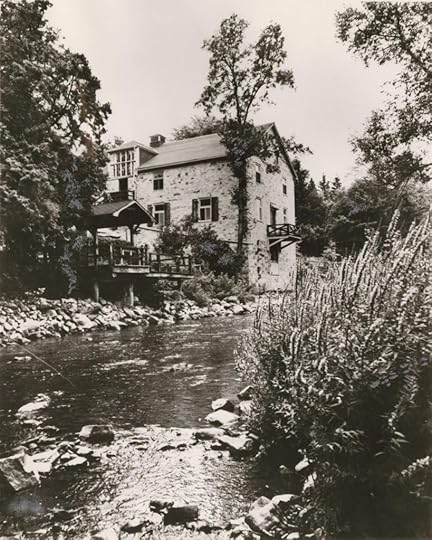
Mill of Kintail – Toronto Public Archives photo
Who is the Ghost of the Mill?
Over the course of many years of the mill’s history there have been reports of certain strange events that to this day remain unexplained.
Some of these involve lights flickering, footsteps, noises, and some areas of the buiding are particularly active.
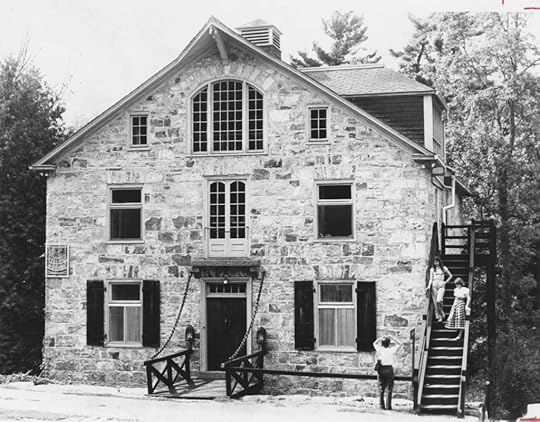
The Baird Family
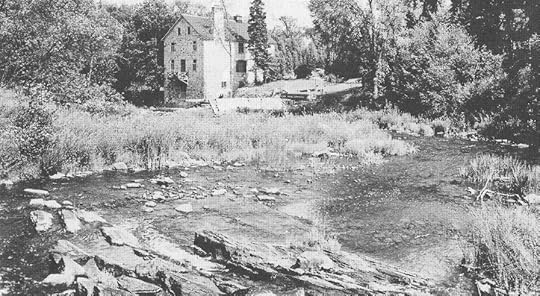
Originally known as Baird’s Mill
Mill of Kintail
Located about ten minutes from Almonte, the Mill of Kintail was built the early 1830s by Scottish immigrant, John Baird. He was a shrewd business man and soon had a gristmill, a general store and a homestead, in nearby Bennie’s Corners. He and his family lived at that location for years, but his offspring had no children of their own and when his last daughter died in 1900, the family line ended.
The Baird family had already lost ownership of the mill because of a legal dispute with his neighbours in the 1860s, and the building was abandoned. The property was no longer kept up, and not long after that, Baird passed away.
Tait McKenzie
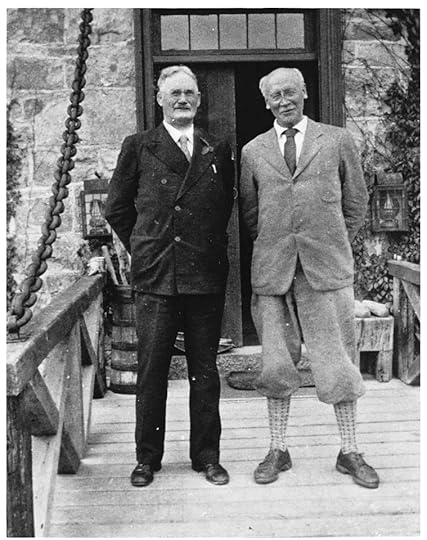
Basketball Inventor James Naismith (left) and Robert Tate McKenzie at the Mill
photo: Mississippi Valley Conservation Authority
Robert ‘Tait’ McKenzie was a well-known doctor, Almonte native, and also known for his artistic talents as a sculptor. In 1930, he returned to Almonte, his hometown, for a local celebration. During his visit he was approached by some members of the community and asked whether he would be interested in purchasing the old mill as a summer home. The locals knew that the site was his old stomping ground where he played with his childhood friend, James Naismith, inventor of basketball.
After some thoughtful consideration, he realized that the property was the perfect spot for both his art studio and a retirement home for he and his wife, Ethel. Although he and Ethel purchased the property and used it mostly as a summer home, McKenzie died suddenly in 1938, and Ethel sold the property in 1952 to Major James Leyes.
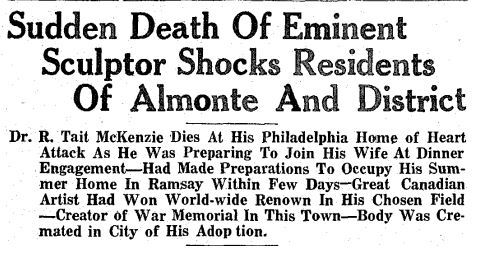
May 5, 1938, p. 1., “Almonte Gazette”
Ethel McKenzie
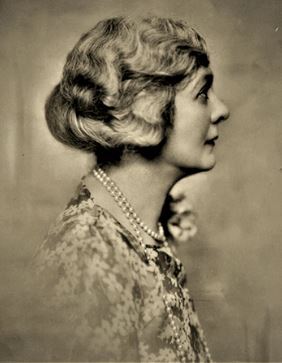
Ethel McKenzie
In 1952, Ethel McKenzie passed away, and was buried beside her husband, Tait, in St. Peter’s Churchyard.
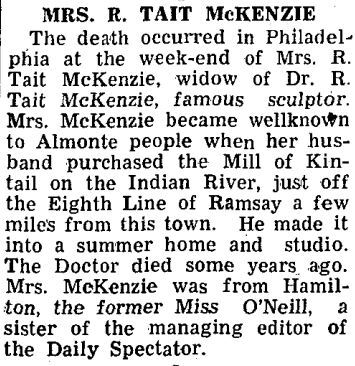
November 11, 1952, p. 1, “Almonte Gazette”
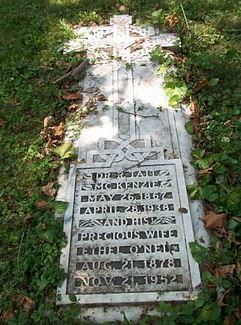
St. Peter’s Churchyard, Philadelphia, Pennsylvania
Museum Built
The Leyes family decided to establish a museum on the site, which became the R.Tait McKenzie Memorial Museum. Many distinguished guests visited the site over the years, and were always impressed by the history, as well as the beautiful landscape surrounding the property.
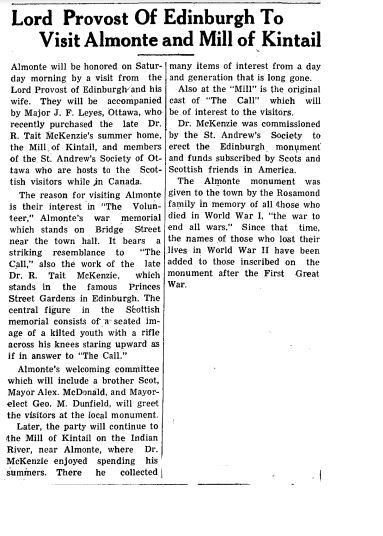
December 11, 1952, p. 1, “Almonte Gazette”
Whose spirit is haunting the Mill of Kintail?
Ethel’s Room
Paranormal researchers have identified one of the ‘hot-spots’ in the mill located in what’s known as ‘Ethel’s Room’, named for Tait McKenzie’s wife. The room contains some artifacts that were owned by Ethel during her years at the mill. It’s been reported that the piano stool is often pulled out when the Curator arrives in the morning. Others have noted that the computer shuts off by itself and suddenly comes back to life on its own. In a live-feed video that was set up in the room overnight, the light came on in the middle of the night, then turned off again, although the building was locked and no one was there.
Over the years, staff and visitors to the Mill have experienced doors opening, closing, and locking by themselves, furniture moving in the night, unexplained noises in the floorboards and stairs, knocking, chilly drafts, and motion sensors being triggered when the building was closed.
On Dec. 4, 2019, Elliot Luijkenaar, and Eric Oickle, from ‘Phantoms of Yore’, an Ottawa-based paranormal group, spent from 7 p.m. until 2 a.m. conducting an investigation into the presence of spirits at the Mill of Kintail.
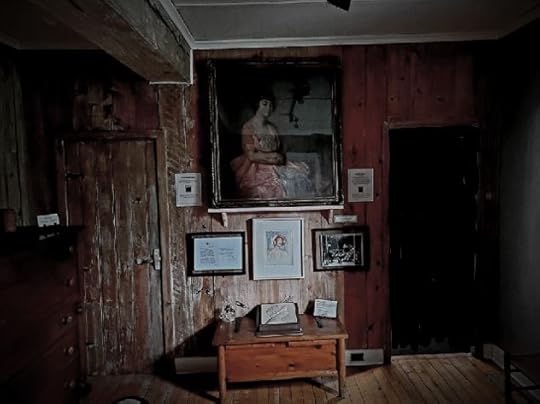
Ethel McKenzie’s room, at the Mill of Kintail
The paranormal investigators set up an electromagnetic field (EMF) meter, an REM Pod, a thermal imager, an electronic voice phenomena recorder, a video camera with the capabilities of infrared and night vision, and a spirit box.
The team later reported that some of their equipment had in fact been activated, and they believed that the energies came from more than one person. They also heard someone say the name, “Nick”, and heard footsteps at the same time. There was a sudden temperature change in the studio when it turned very cold, and their EMF meter was quite active, particularly when it was positioned near the staircase.
The team was so convinced of their findings, that they offered the public an opportunity to take part in one of their evening sessions at the mill. Participants attending the paranormal workshop would be shown how to use the tools of the trade; participate in discussions, and enjoy a historical presentation.
As far as the staff of the mill, it’s been reported that they are content to spend their time with a visit from an occasional spirit, and claim they are friendly, though noisy at times.
Preserved for
the Future
In the 1970s the deed to the mill was transferred to the Mississippi Valley Conservation Authority and they have maintained the mill and surrounding property beautifully ever since.
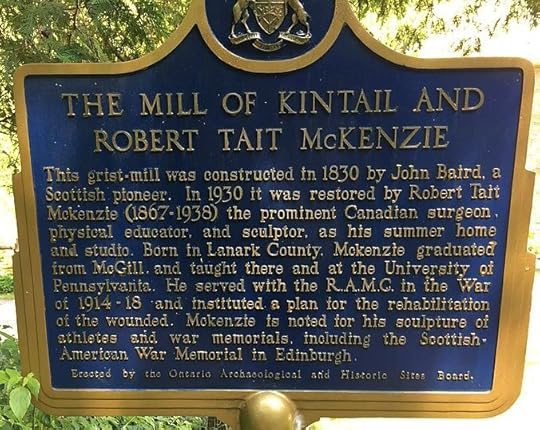
Whether or not you believe in the possibility of ghosts at the Mill, it is a lovely spot to spend the day, taking in the museum’s rich history, as well as the beauty that surrounds the property. The Mill of Kintail is surely one of Lanark County’s gems, and well worth a visit, to do some exploring, and maybe make some new memories, spending time in this historic and beautiful site.
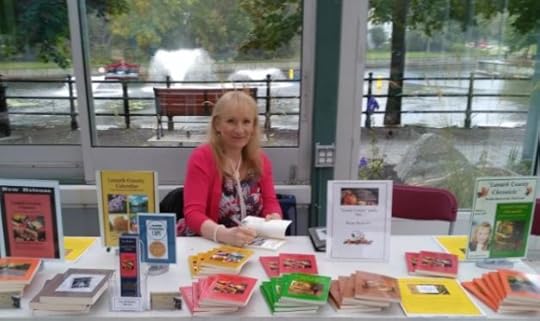
Arlene Stafford-Wilson
Arlene Stafford-Wilson
Member of the Lanark County Genealogical Society
Member of the Association of Professional Genealogists
Author of 10 books, “Lanark County Christmas”, “Lanark County Comfort”, “Lanark County Collection”, “Lanark County Calling”, “Lanark County Classics”, “Lanark County Connections”, “Lanark County Calendar”, “Lanark County Chronicle”, “Lanark County Kid”, and “Recipes & Recollections”
October 7, 2022
Carleton Place Haunting
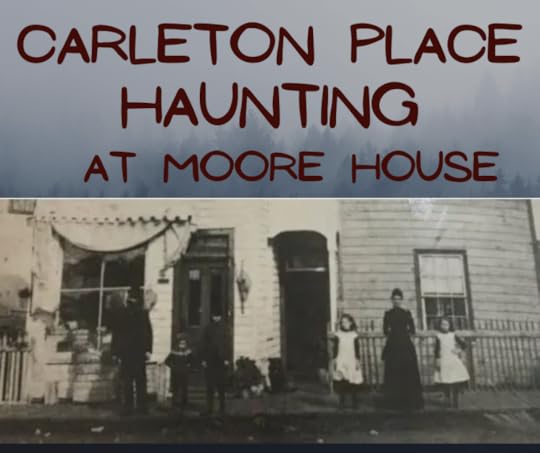
When a team of analysts from the Ottawa Paranormal Research and Investigations (OPRI), paid a visit to Carleton Place’s ‘Moore House’, in January of 2013, they had no idea what to expect.
For many years there had been rumours and gossip, stories of ghostly sounds, objects moving, sudden changes in temperature, and a long list of other sightings and events that caused the team of investigators to visit this historic place.
Moore Family
The Moore family home was built in 1850, by a settler from Ireland, Nathanial Moore, and his wife, Margaret Pearson. They had four children: William, James, Jayne Ann ‘Rossie’, and Richard.
James, the second eldest son, and his wife, Catherine Roberts, inherited the home from his parents, and in turn, raised their own children there.
James and Catherine Moore, had a family of five: Nathaniel, born in 1875, John in 1876, a daughter Ida Louise in 1879, another girl, Clara in 1882, and a son, Ernest in 1885.
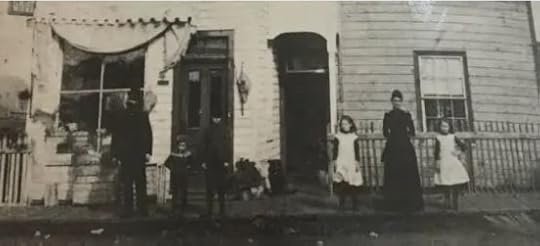
The photo above shows the section of the Moore family house which was converted to a small general store, known as, JP Moore Groceries and Confectionery. This photo is from the late 1800s
(left to right – James Moore, his sons, Ernest, Herbert, daughter Ida, wife Catherine, and daughter, Clara)
The Moore’s third child, Ida Louise, was not only lovely, but was also a gifted musician, and became known for her technically impressive, as well as moving, performances on the piano.
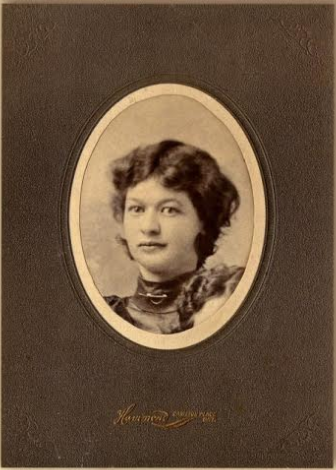
photo of Ida Louise Moore –
Carleton Place & Beckwith Heritage Museum
Local lore says that Ida’s talent was well worth pursuing in a professional capacity, and that she had planned to attend music school, and either perform professionally, or possibly teach music one day.
Ida’s Death
In a sad twist of fate, the promising young musician caught tuberculosis, and became quite ill. Eventually, in 1900, at the tender age of 20, Ida passed away. It was said that the whole town mourned at the loss of such a lovely young lady, and one with so much promise for a bright future. With heavy hearts her parents, James and Catherine found a lovely plot, under some tall shade trees, at St. James Anglican Cemetery, just north of Carleton Place.
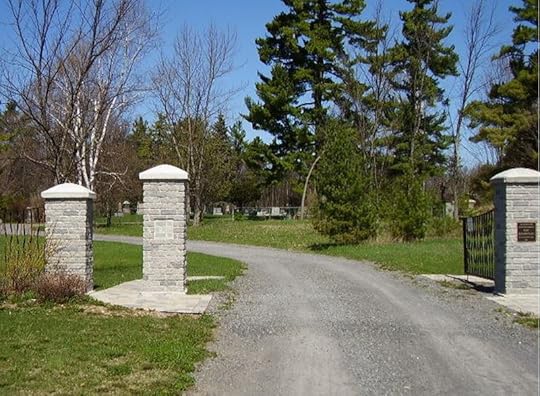
St. James Anglican Cemetery
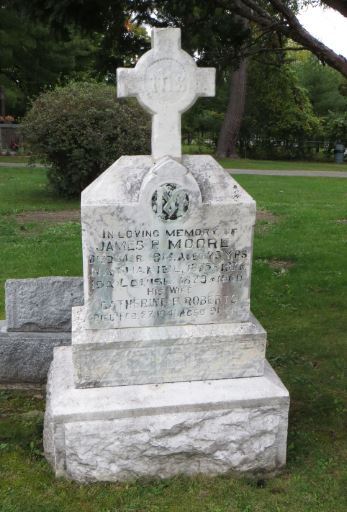
Moore family headstone, St. James Anglican Cemetery, Carleton Place
Spooky Store
Eventually, the Moore family sold the home, and the new owners continued to operate the small general store. It was after the building changed hands that the strange and unexplained events began to take place.
Reports of unusual sounds and changes in temperature at the store began to make the rounds, up and down the streets of Carleton Place. There were stories of sudden drafts, and of windows opening and closing on their own, the radio also turned off and on by itself, and footsteps were heard, even when no one was in the building. Many employees refused to work alone in the building, and eventually it became difficult to find people who would agree to work there at all.
Paranormal Investigation
In 2013, when the Ottawa Paranormal Research and Investigations team members conducted their research at the Moore House, their three-hour term of analysis included numerous video and audio recordings designed to detect electronic voice phenomenon (EVP) and other indications of paranormal activity. Their equipment included: electromagnetic field (EMF) meters, thermal imagers, video cameras fitted with infrared and night vision, spirit boxes, computers, and smartphones.
What Did They Find?
The team returned to the Moore house in July of 2013, to discuss their findings. Present at the meeting were Chamber staff, members of the media, a Moore family descendant, Frances Moore, and her partner Jim Smithson.
The first piece of evidence shown to the group was a video clip, taken in the loft at the beginning of the investigation on Jan. 13. Analysts John Moore (no relation), and OPRI Psychic, Craig Leafloor, were conducting the initial walk-through.
Thermal Image
One of the research team revealed a thermal image captured by using the thermal imaging camera.

“That chair should not be white,” he explained. “That is heat.” “No one had sat in that chair, but you can clearly see the legs and torso.”
It was a bit of a surprise, and quite strange to have a heat signature showing up in a chair that no one is sitting in; especially white hot like that.
Electrical Interference
At one point during the evening, their recording picked up what sounded like electrical interference.
“Usually, if we get electrical interference, we get it multiple times, it comes in intervals,” he said. “You do not hear it once in a three-hour recording.” The noise can be heard beneath the voice of an investigator.

The Sound
of Music
Knowing that Ida was an accomplished pianist, the team attempted to make contact with her using an electric keyboard , as a trigger object.
Using a spirit box, one of the researchers asked, “Ida, what instrument do you like to play?”

Spirit Box
After a brief pause, a noise came from the keyboard.
According to the researchers everyone heard the noise, and the keyboard was not plugged in at the time.
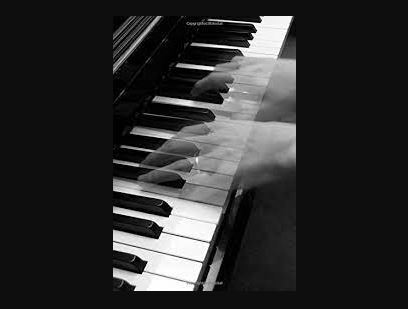
A Gentleman?
The research team also revealed that just before everyone heard the keyboard, two voices were also heard in the room – a male and a female.
Two separate pieces of equipment recorded the voices, and the word, “No” is said by the male voice, followed by a “Yes”, from the female voice.
In an interview with the “Canadian Gazette”, the research team concluded that the spirit of Ida was still in the Moore house, along with a gentleman’s presence.
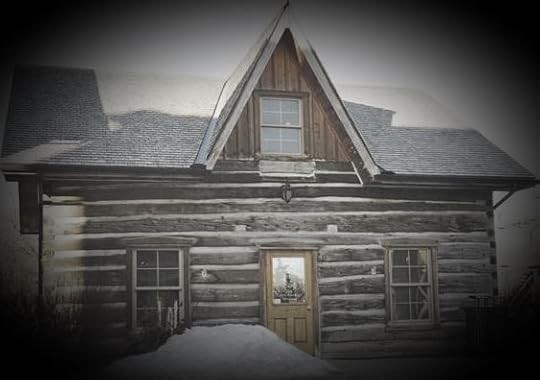
Moore house in more modern times, 170 Bridge Street, Carleton Place
House was Moved
The Moore house was originally built at the north end of Moore Street, opposite Lansdowne Avenue. The building was donated to the town, and in 2007, the structure was raised from its foundation and moved to 170 Bridge St. The building is currently the site of the Carleton Place & District Chamber Of Commerce and Visitor Centre.
According to some family members, the Moore family were “known to have the sixth sense, an ability to perceive the unseen world of angels, ghosts, heaven, auras, etc.”
Local residents say that a realtor, Walter Renwick, owned the property for many years, and that members of his family reported unusual things upstairs where their bedrooms were located. They reported objects moving, breezes flowing through rooms when the windows were closed, and a strong scent of lavender from time to time. It’s also been said that the day Renwick sold the home, a framed photo he had of the house fell to the floor and shattered into pieces.
Lavender
Some paranormal researchers claim that the scent of lavender is one of the signs of a friendly spirit. Down through the ages we’ve come to know that lavender symbolizes purity, faith, and love; and for a certain young lady living in Carleton Place so many years ago, it may very well have been a favourite.

Today, Moore House is the bright, welcoming Carleton Place Visitor Centre and the Carleton Place & District Chamber of Commerce.
Are there still spirits at Moore House? Why not go and see for yourself!
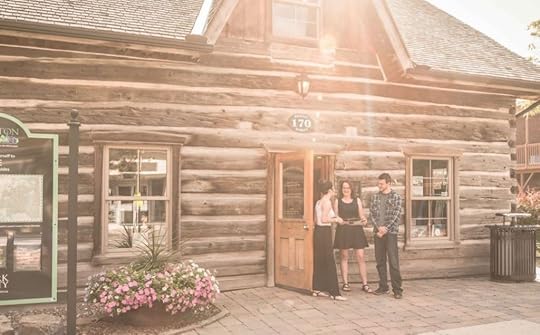
photo: Carleton Place Chamber of Commerce
.

Arlene Stafford-Wilson
Member, Lanark County Genealogical Society, Member, Association of Professional Genealogists, APG
Author of:, “Lanark County Christmas”, “Lanark County Comfort”, “Lanark County Collection”, “Lanark County Calling”, “Lanark County Classics”, “Lanark County Connections”, “Lanark County Calendar”, “Lanark County Chronicle”, “Lanark County Kid”, and “Recipes & Recollections”
October 6, 2022
Balderson’s Grisly Murders
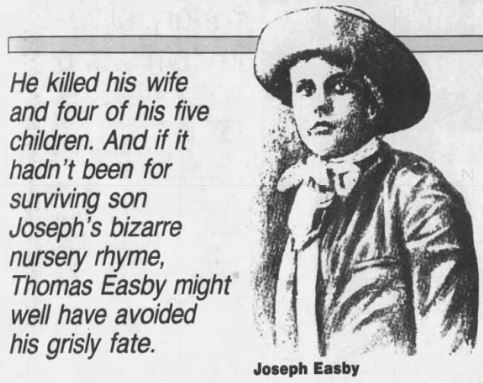
December 10, 1828
near Balderson, Ontario
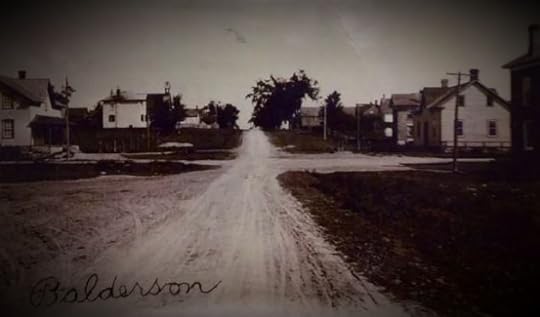
On a cold, dark, December night, right around midnight, Sinclair Tullis’ mother woke to a blood-curdling scream coming from the direction of their neighbour, Thomas Easby’s house. She sent her son to investigate and he could see that the Easby home was engulfed in flames, and heard his neighbour’s voice call out, “Who is there?”
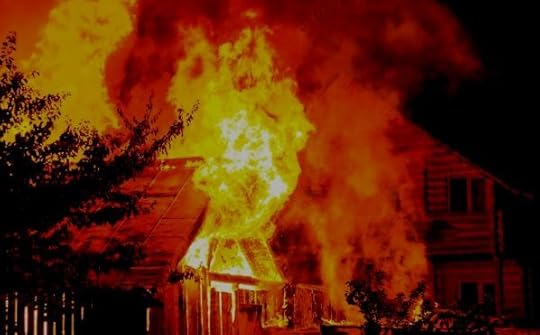
Tullis asked him what happened, and Easby replied, “Go home. The fire is under control. I will be awake until morning.”
When Tullis returned the next morning Easby told him that all of his family had burned to death except his youngest son, Joseph, who sat quietly on the ground, not far from his father. Thomas’ wife, who was eight months pregnant, their daughter, and three sons, were all dead.
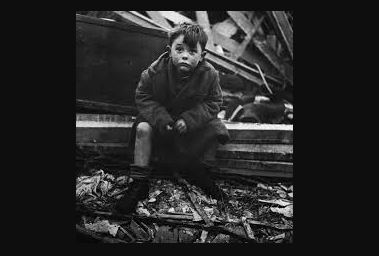
Mrs. Martha Richardson, a neighbour, volunteered to look after young Joseph Easby, age four, and although, understandably he was still in shock, she found that he was doing some very odd things. He often sang morbid songs while he was playing, “Father killed mother, sister, and three brothers.” Mrs. Richardson found these songs quite disturbing, as well as some of the games he played. Sometimes he would point to the handle of their shovel and claim that his father had struck his mother with one just like it. He also played a game where he pretended to cover his dead siblings with hot coals.
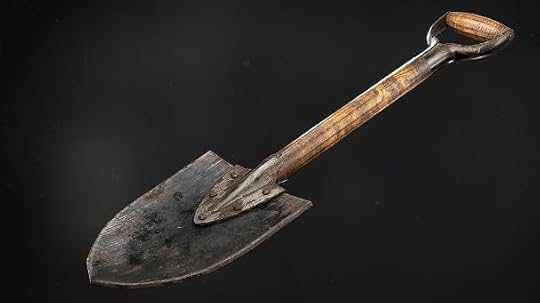
After a few weeks, when Christmas had past, and young Joseph continued to play the strange games, and sing the shocking songs, she informed her neighbour, Sergeant John Balderson, a former infantry soldier. He began to make inquiries and spoke with some of the legal officials in Perth about the young lad’s odd behaviour.
In February two magistrates, along with Dr. James Wilson and Coroner William Matheson went to speak with Thomas Easby and grew suspicious after he gave them his explanation of what happened that fateful night. They ordered an exhumation of Easby’s wife and children, and an examination was done by Dr. Wilson, who determined that Mrs. Easby’s skull was fractured in five places, and the children’s skulls also showed signs of blunt-force trauma. Easby could not explain how these injuries happened.
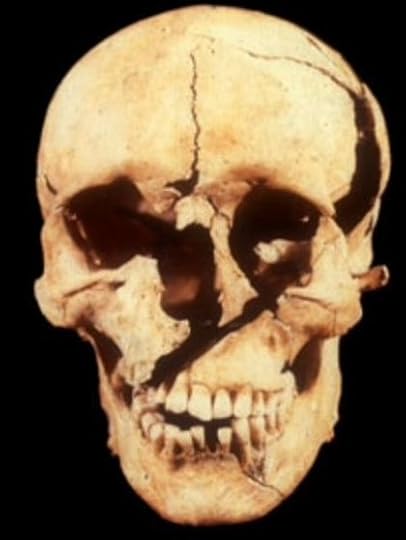
The following day, John Balderson, Dr. Wilson, and the local Jailer, James Young, told Easby that his family had been murdered. Easby began to cry, and said that he’d killed them all with a thick branch from a Birch tree. He insisted that he had only intended to kill his youngest child, Joseph, but that the child had looked up at him and smiled, and so he killed all of the others instead.
The Trial
At his murder trial, Easby addressed the court, “I was in a perplexed and insensible state of mind at the time of the murder and had only a faint recollection of what occurred. I seemed to have no power of myself, no volition of my own. But, I was impelled to the act by some mysterious agency, which entered my abode and appeared to assist me. After the dreadful tragedy I called some of my family by name, and discovered what I had done, and I exclaimed to myself, “Oh! My God, I have murdered them.”
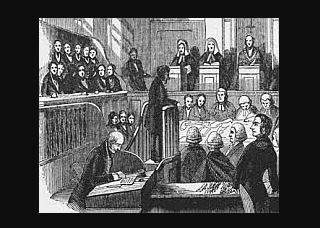
The trial judge, Chief Justice Sherwood, after pronouncing Easby guilty, declared, “Your days are numbered, your mortal course is finished.”
Easby was hanged on November 13, 1829, before the largest crowd ever gathered in Perth, Ontario. Local newspapers praised the skill of the hangman in his execution of the guilty man.

Easby’s body was buried in the Anglican section of the Craig St. cemetery, but later that same night, his remains were exhumed and delivered to the local surgeon and his medical students for the purpose of dissection. According to “The Perth Courier”, “They first skinned the body, and the hide was rolled in salt and afterwards tanned in a local tannery and cut up into small squares, which were sold to the public, bringing as much as two dollars.”
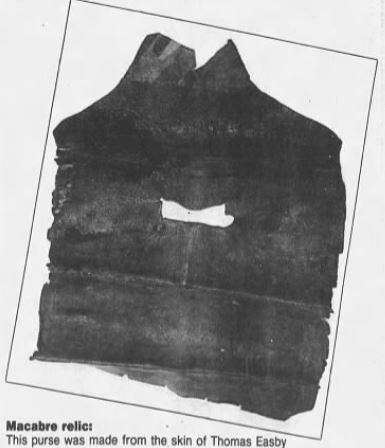
In the 1980s, a reporter from “The Perth Courier”, Michael Taylor, decided to search the area for anyone who might still be in possession of Easby’s skin. Eventually, he located Mrs. George Smith, of Balderson. She had made a purse from Easby’s hide. Another area resident, Alex Balderson, had a strip of the ‘Easby leather’, and had made it into a bookmark. He claimed that it was kept in an old family bible. In faded ink, on the back of the bookmark there was a quote from the Bible, “Whoever strikes a man so that he dies shall be put to death.”
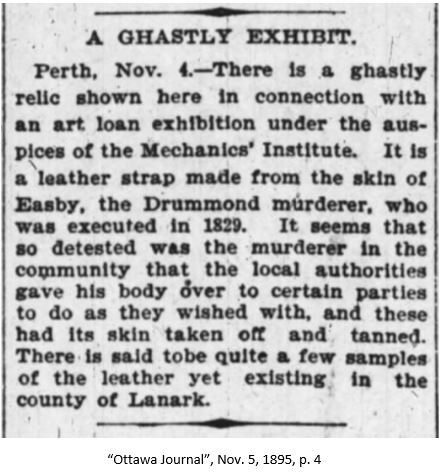
Hide was Sold
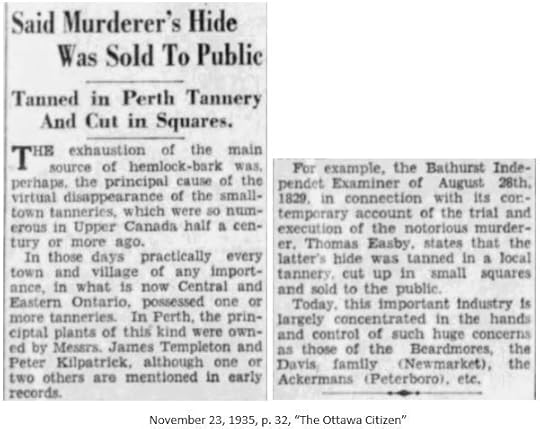
Jail Employees Recall
Stories of Easby
It’s been said that of all the convicted criminals who were hanged in Perth, Thomas Easby was perhaps the most notorious. When it was announced in the summer of 1994 that the Perth jail was closing, “The Ottawa Citizen” sent a reporter, and the employees recalled hearing the stories of Easby’s hanging.

According to one of the workers at the Perth jail, “He (Easby) was kept in the original Perth Jail for several months before he was publicly hanged, the rope adjusted with great dexterity in front of a huge crowd of townspeople. Then his body was dug up, skinned, and tanned, and the bits were sold off and made into wallets and knick-knacks.
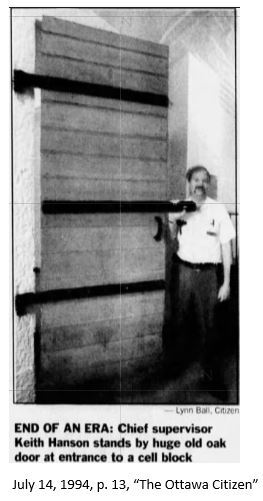
Chuck Stewart, the Superintendent, said that many more people were hanged over the years in Perth, and that the last hanging was in 1910, at the permanent gallows, at the back of the jail. The noose hook has since been covered by a light fixture, and the lever which activated the trap door in the floor has been removed. In its place is a chair on the wooden floor overlooking the exercise yard.
“Murder, as foul as it comes.”
When asked about the future of the jail, Stewart said the cells and prisoners’ areas are tiny and the plumbing and electrical systems are a nightmare. There are rumours of turning it into a bed and breakfast, but according to Stewart, “Bed and breakfast people don’t like sleeping in cells.” Ottawa Citizen Reporter, Kelly Egan, added, “…and who would rest easy on the ground where Thomas Jeremiah Easby met his gruesome end, for murder as foul as it comes.”
What Became of
Little Joseph Easby?
And what became of young Joseph Easby, orphaned at the age of 4, and the only surviving member of his family? In a letter dated in 1857, regarding the estate of Joseph Easby, he had drowned at age 32, unmarried, after falling from a ship in the Toronto harbour.
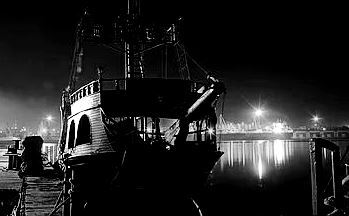
In the small community who lived around Balderson, the story of the tragedy that took place at the Easby farm was told and re-told down through the generations; and although they are fewer in number these days, some still claim to possess items fashioned from the hide of Thomas Easby.
Anyone who has visited the pretty hamlet of Balderson, and knows their long history and stellar reputation for cheese-making, would no doubt be surprised to learn of the gruesome and grisly events that took place at the Easby house, on that dark, cold, winter’s night in 1828.
Further reading: A book was published in 1903, written by Robert L. Richardson, the grandson of Martha and Thomas Richardson, who cared for little Joseph Easby, until he was adopted and raised by a couple in Toronto. His book, “Colin of the Ninth Concession”, was loosely based on the Easby murders.
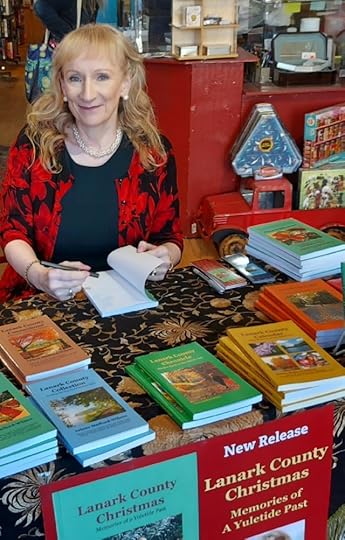
Arlene Stafford-Wilson
Author of: “Lanark County Christmas”, “Lanark County Comfort”, “Lanark County Collection”, “Lanark County Calling”, “Lanark County Classics”, “Lanark County Connections”, “Lanark County Calendar”, “Lanark County Chronicle”, “Lanark County Kid”, and “Recipes & Recollections”
October 5, 2022
Rideau Ferry’s Dark Legend
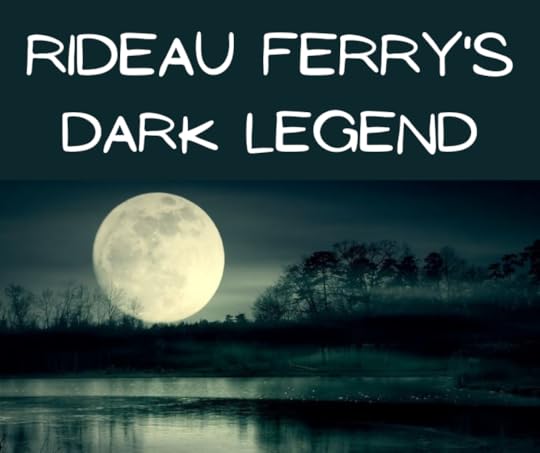
The legend of the notorious John Oliver begins in 1816 when he and his family settled on the south shore, on Lot 21, Conc. 5 of Elmsley Township, and John began to operate a ferry service on the Rideau Lakes. Over the years there were stories of travellers who went missing, of bones found under a house, tales of fighting among neighbours, and of a grisly murder.
Oliver’s Ferry
Back then, early surveyors reported a distance of about 450-500 feet, at the narrowist section for crossing the Rideau Lake, so anyone traveling to Perth had to pay Oliver to cross from one side to the other if they didn’t own a boat. This community today is known as Rideau Ferry, but at that time, because of John’s thriving business, it was known as Oliver’s Ferry.

Oliver’s Ferry, August 20, 1830, by James Pattison Cockburn, Library and Archives Canada
Travellers Disappeared
John Oliver’s ferry, a rough wooden raft, was a link to the roads leading from Brockville and Perth. John had a most unusual habit. He refused to transport travellers across Rideau Lake to the other side after dark, and always offered to accommodate them at his home overnight and then transport them the following morning.
His neighbours claimed that they seldom saw the travellers the next day. When people in the area asked about the travellers John stated that, “They went on their way at first light. You must have been asleep”. It was said that a number of these travellers who stayed overnight at John’s house never arrived at their destination.
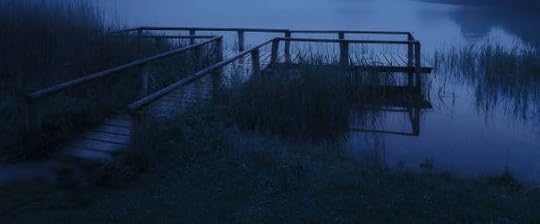
John’s Suicide
When local minister, Rev. William Bell visited Oliver’s Ferry on his way to Perth in 1817, he later noted in his diary, that John Oliver, “appeared to have a somewhat unstable personality”. This observation proved to be true when news came of John’s death by suicide, after he shot himself in 1821.
William Oliver
Takes Over
After his father’s sudden death, William took over the ferry business.
Did John in fact take his own life, or did his son, William, who was said to be both violent and ambitious, cause his father’s death?
Stories of William’s temper were well known in the area and stories suggested that he continued his father’s ghastly habit of killing travellers, stealing their possessions, dismembing their bodies and hiding the remains under the floorboards of the Oliver house.
William was also known to have frequent and violent arguments with his neighbours, and it was said that almost everyone disliked him. He often had disagreements with his neighbours, some of which turned violent. He was also known to pursue other men’s wives, an in particular the wife of William McLean who lived across the river. His habit of being a womanizer did not increase his popularity in the community around the Rideau Lakes.
On a hot summer’s day in July of 1842, his violent nature rose to the surface again when the neighbour’s cattle, from the Toomy farm, were found trespassing on Oliver’s property. William headed straight to the Toomy’s place, confronted the two Toomy brothers, and punched one of them.
“The Perth Courier”, in its July 26, 1842 edition reported that the Toomys retreated to their house and that Oliver followed them there. One of the Toomys grabbed a loaded gun and told Oliver to get off their property. As Oliver tried to wrestle the gun from Toomy, the gun discharged, shooting Oliver through the heart. He was killed instantly.
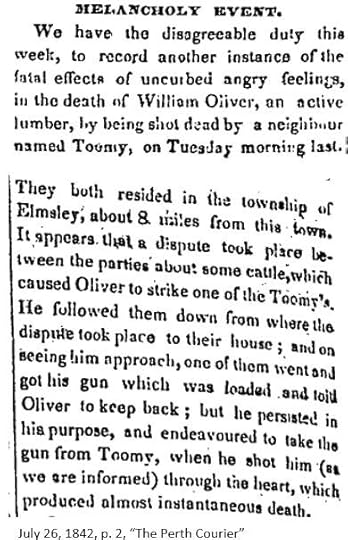
Rev. William Bell of Perth stated, “The tragical death of William Oliver, at the Rideau Ferry on the 19th, creating at this time a universal thrill of horror. It was dreadful to think of a man so profanely wicked as he was, being sent into eternity in a moment.”
Word spread quickly through the county, and on July 20, Peter Sweeney, Lockmaster at Jones Falls, noted in his diary “I heard that Mr. Oliver was shot by a neighbour at Oliver’s Ferry.”
“On Wednesday morning, July 20, 1842, an inquest was held upon the body, before W.P. Loucke, Esq., Coroner, when the Jury returned a verdict of Manslaughter against William and John Toomy, the evidence being contradictory as to which of the brothers had committed the deed. We understand they were sent to Brockville jail, to await their trial.”
“The Perth Courier”, July 26, 1842, p. 2
The Toomy brothers were jailed and both later convicted of manslaughter.

Oliver’s Ferry – Rideau Lake, 1834 – Archives of Ontario
One local legend passed down through the generations states that when the Oliver family’s buildings were torn down to make way for the new bridge built across the narrows in 1874, human bones were found both inside of the walls and under the floor boards.

Oliver’s Ferry 1828 looking south This shows the south shore where the Oliver family’s house was located (in red)
The bottom shows the north shore and the road to Perth. from: 1828, Scottish Records Office
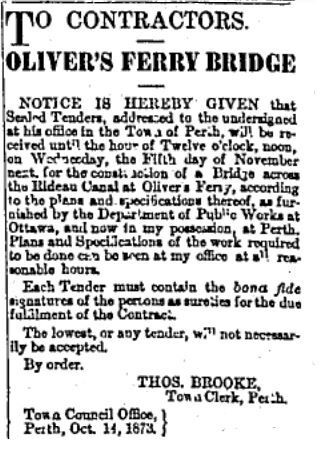
“The Perth Courier”, October 17, 1873, p. 4
Human Skeleton
Discovered
In 1873, when bids were being submitted on the contract to build a bridge to replace the ferry there was an alarming article in the local newspapers stating that there was:
“a discovery of a human skeleton under the platform of a house
near the wharf that was undergoing repairs.”
After the bridge was completed in 1874, there was no longer a need for a ferry service.
Both the original ferryman, John Oliver, and his son, William were gone – the father, by a self-inflicted gunshot, and the son, shot through the heart by his neighbour.

The legend of Oliver’s Ferry is one that’s been passed along for over 200 years, since 1821, and the unsettling death of John Oliver. His son William’s tragic demise adds to the mystery and intrigue of this fascinating tale!

Who were the travellers staying overnight at the Oliver’s home, and were they ever seen again?
Did authorities identify the human skeletons found under the wharf when they were building the Rideau Ferry bridge?
This fascinating story of the Oliver family remains one of Rideau Ferry’s dark legends!

Arlene Stafford-Wilson
“Revelry and Rogues on the Rideau”, a story in “Lanark County Chronicle”, tells the tales of John Oliver, and of Coutts House and the Rideau Ferry Inn, and of Al Capone’s rum-running days, and a secret tunnel built so he and his men could escape from their hideaway and cleverly evade the local police.
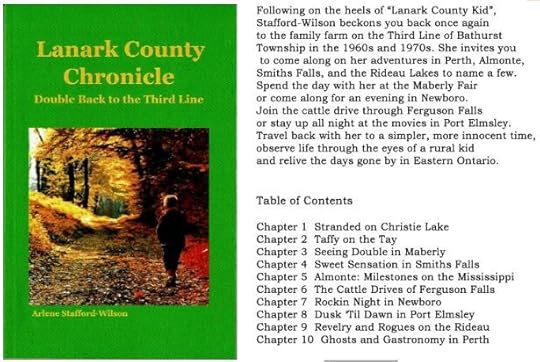
Available at, The Book Nook in Perth, Mill Street Books in Almonte, and Spark Books in Perth
contact: lanarkcountybooks@gmail.com
October 4, 2022
Irish Graveyards

Drawing: Rory O’Shaughnessy, “Ireland Reaching Out”
Irish Graveyards
Some of the older Irish graveyards date back to medieval times, and often there are structures or ruins of the old churches around which the graveyard and parish evolved. Commonly known as graveyards, burial grounds or cemeteries – the word “cemetery” was adapted by the early Christians from the Greek word “koimerterion” meaning sleeping place or dormitory.
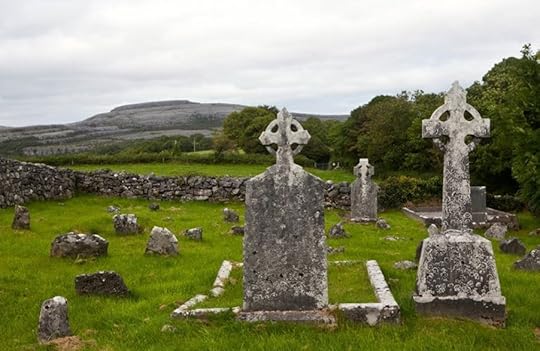
There are a small number of seventeenth-century tombstones, also known as tapered grave-slabs and also some mural plaques found at a number of Irish graveyards. This type of monument was more commonly placed by the wealthy members of the parish and are likely to be located at the residences of the various religious orders. It was not uncommon for many people to have a simple stone or a cross, (not inscribed) marking their grave.
Tomb Types
Like many things in life, the type and construction materials implemented in a tomb were often a reflection of a family’s wealth or position in the community. Some types of tombs were more historic in nature and were unique to a specific time in history when that particular type of tomb was in fashion.
Altar Tomb – A rectangular, raised tomb, commonly used by early Celts

Bale Tomb – Resembles a chest tomb, with a rounded top

Barrel Tomb – Has a curved top which may or may not extend to the ground

Chest Tomb – Resembles a large trunk or container

Hip Tomb – A rectangular box with a hip roof added to the top.

Table Tomb – Appear to be a stone table, and normally supported by 6 legs

Pedestal Tomb – A tomb placed on a pedestal
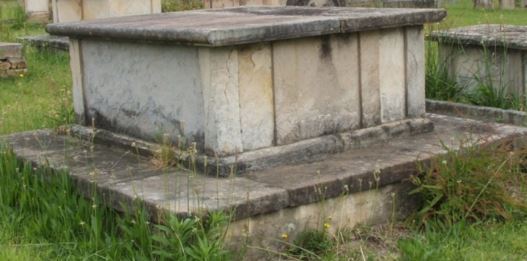
Family History

For family historians, a search through a graveyard can be a rewarding experience if you’re lucky enough to find the markers you’re looking for. In some cases grave markers with names of families who no longer live in the community might be found. Some of the families left the area because of mass-emigration, death through famine, or changes in the political, religious or social evolutions in the community. These events can provide challenges for local genealogists searching for the gravestones of a particular family.

Yew Tree
The yew tree is a common sight in an Irish graveyard. The ‘tree of death’, or Yew, is a slow-growing, long-living tree, common in many parts of Europe. An older yew will often hollow out in the center, then send down a shoot which begins the growth of a new tree, or a tree within a tree. The ancient Druids worshipped the tree, and often buried their dead beneath a yew. When the newly-converted Christians in Ireland began to bury their dead, the bodies were often added to existing pagan cemeteries, which always had at least one yew tree on the grounds. The Christian clergy eventually incorporated the planting of the yew and its ability to generate new life, as a symbol of the resurrection.

Wrought Iron
Markers and Fences
At one time wrought iron was a common material used throughout Ireland, and many grave markers and fences surrounding tombs were created by talented local blacksmiths. The old English term ‘wrought’ is the past tense of a Medieval word meaning ‘to work’, and in this case the white-hot metal was forged with a hammer.
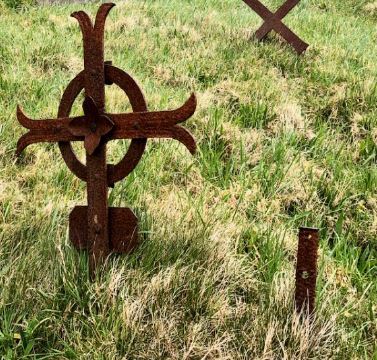
Wrought iron fences were built around individual graves or family tombs.

Some families chose a stone curbing around a tomb.

Ledger Stones
A ledger stone was a flat stone and had an inscription about the deceased, and often displayed symbols related to their profession, their religion, or their affiliations to a group. These stones were sometimes placed on the top of Chest Tombs.

Grave Symbols
Memorial stones may help us with our family history research through their unique individual markings. Some have vocational symbols, depicting the type of work done, or a family coat of arms, or perhaps a Masonic symbol indicating lodge membership. In the case of a Masonic Lodge symbol further information may be found in the local or national lodge records.

Gravestone with Masonic Order Symbols
Obelisk
Obelisk markers are usually found on family burials or those of people of high social status, and they also tend to stand out more in the cemetery and are easily located. The advantage of the shape is that it provides four engraving surfaces, rather than just one, as in a standard headstone. The shape and height also relates back to the Celtic pagan worship of the sun god. In more modern times this shape was favoured by familes wanting to display their wealth or power.
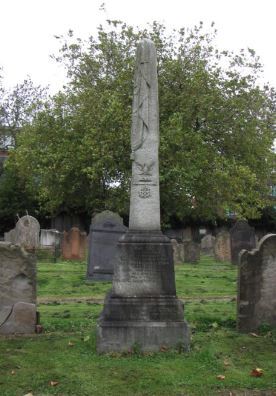
Celtic Cross
The religious denomination of the deceased can often be established through the types of religious symbols used on their memorial. Usually, resurrection symbols are more frequently associated with Catholic memorials while mortality symbols are used more commonly on a Protestant grave marker.

A symbol of Christianity, the Celtic cross first appeared in the 8th century. Legends say that Saint Patrick introduced the Celtic Cross to Ireland and that the circle within the cross symbolizes the pagan sun, or the old beliefs, and the cross represents the conversion to Christian beliefs by the early Irish Celtic people. The circle was a powerful symbol to the ancient Irish people, and it was considered a sign of strength and many rituals were performed while standing in a circle. Several ancient monuments, such as Stonehenge were constructed in a circle, because the unbroken formation was believed to hold magical powers. It’s been thought that St. Patrick incorporated the circle within the cross knowing it was a meaningful symbol to the Celts.
Catholic Grave Symbols:
The letters “IHS” may be engraved on a cross. These letters represent – Iesus Hominem Salvator (Jesus Saviour of Mankind). The Greek letters Alpha and Omega can also appear on a gravestone to symbolize the beginning and the end.

“IHS” carved in the centre of the cross
Protestant Grave Symbols:
One of the most common symbols on Irish Protestant (and some Catholic) gravestones is a simple three letters: “R.I.P.”, in Latin: “requiescat in pace“, in English: “Rest in peace”. The letters represent a longer prayer which is:
“Eternal rest grant unto him,
And let perpetual light shine upon him;
Rest in peace.”
Amen.

The Clasped Hands
In the eighteenth-century there was a “Great Awakening”, when Protestantism began to change their focus to salvation and a personal relationship with God. The symbol of the clasped hands were often accompanied with words: “farewell”, “goodbye,” and “until we meet again.” The carved hands were almost always portrayed as right hands and they represent a husband and wife sharing a last handshake. One hand is usually flat and loose, its fingers extended, which may be interpreted as either a final embrace, or the deceased leading the living to follow them.
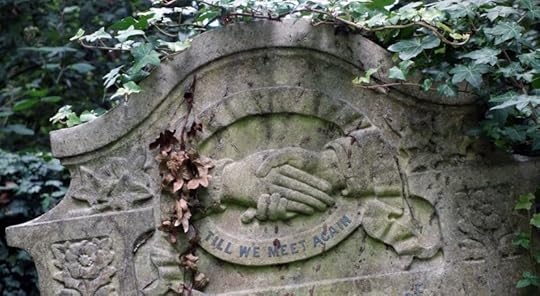
Many of the Irish Protestant graves have what was known as “mortality symbols”, which were thought to remind people that life is fleeting, and to seize the day. The skull and crossbones are probably the oldest mortality symbols found in Irish graveyards. Often an hour glass is combined with the skull and crossbones symbols to signify time running out, or sometimes a winged death’s head also indicating that life is short.

This is the gravestone of a man who was a wood-cutter, and bears the symbol of a Forrester with an axe in his hand, as well as Adam and Eve beside the Tree of Life.
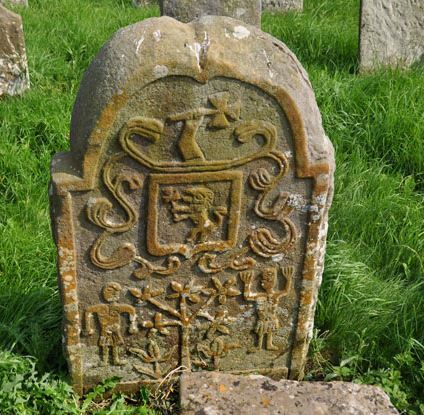
The symbols of the skull and the hourglass were known as ‘mortality symbols’, and were a reminder that a lifespan is brief. The hourglass, crossbones, bell, and skull are frequently seen together on 18th-century gravestones. The bell symbolized the church bells that rang to call the people to a funeral. These symbols were more commonly used on Protestant grave stones.

Some gravemarkers were engraved with rhymes or messages:
“Remember me as you pass by,
As you are now so once was I,
As I am now you soon must be,
Prepare for death and follow me.”
Burial Records
Note that burial records, also known as ‘plot books’, as well as maps of Irish graveyards are usually more recent in origin. The majority of records of historic graveyards in Ireland go back no further than the early twentieth century, with only a few dating to the nineteenth century.
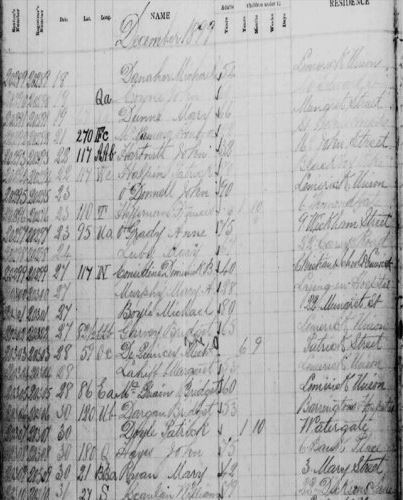
A page from the burial records of Mount St Lawrence Cemeter, County Limerick
Local History
When possible, it may be best to find someone with local knowledge to identify individual family plots. While a local historian may not be able to confirm all individuals buried in the grave they may be able to assist with other important information such as where the family lived and what other families they are related to within that parish. Local guides and historians may be able to trace back people and events over a long period of time, so should never be overlooked as a source of information.

If you have Irish ancestry, Irish graveyards and their markers can provide a wealth of information for those researching their family history. From the ancient pagan symbols, to the more modern symbols and markers used today, the gravestones represent a physical link back to our forebearers, and they provide us with clues to who they were, and how they lived.

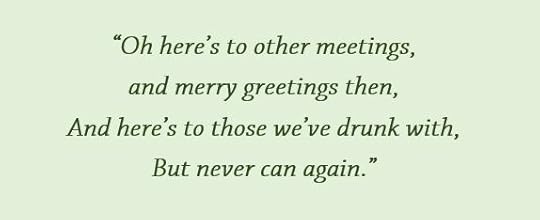

Arlene Stafford-Wilson
Member: Lanark County Genealogical Society
Association of Professional Genealogists, APG

Author of: “Lanark County Christmas”, “Lanark County Comfort”, “Lanark County Collection”, “Lanark County Calling”, “Lanark County Classics”, “Lanark County Connections”, “Lanark County Calendar”, “Lanark County Chronicle”. “Lanark County Kid”, and “Recipes and Recollections”.
October 3, 2022
Money in the Cake!
One of the highlights of celebrating a birthday at the Stafford house was finding money in our cake. Our mother carefully wrapped quarters, dimes, and nickels in small squares of waxed paper, and she inserted them in between the layers of the cake.


Once the two layers of cake were baked and cooled on the racks, Mother would ice the bottom layer, and then place the coins wrapped in waxed paper on top of the icing, before adding the second layer, so that they were sandwiched in between the two layers.

After the money was placed between the layers, Mother iced the cake as usual, along the sides, and the top.

We all loved Mother’s chocolate cake, but for her birthday each year, Judy preferred Mother’s banana cake with chocolate icing.
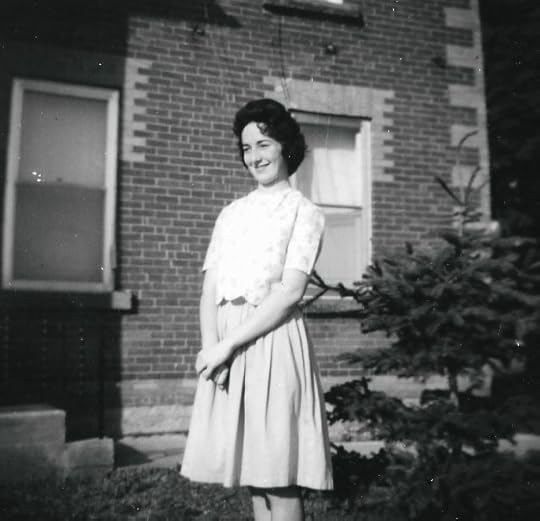
Judy (Stafford) Ryan at the Stafford house, Third Line of Bathurst, 1960s
Mother’s Farmhouse
Banana Cake
1/2 c. shortening
1 1/2 c sugar
2 eggs
1 c mashed ripe bananas
2 c flour
1 tsp baking powder
1 tsp baking soda
1/4 tsp salt
1 tsp lemon juice
1 tsp vanilla
1/2 sour milk
1 c walnut pieces chopped
Mix batter, and spoon into 2 layer pans, and bake for 30 minutes at 325 degrees.
Cool when baked, ice first layer, and add coins wrapped in waxed paper, finish with your favourite icing.

When those cool fall winds blow, and the leaves are showing of their firey reds, brilliant oranges, and sunny yellows, our family remembers Judy’s birthday, each year, on October 3rd, and the excitement of finding those dimes and nickels hidden in her banana birthday cake!

Happy Birthday Judy!
Audry Stafford’s Banana Cake recipe from:
“Recipes & Recollections: Treats and Tales from Our Mother’s Kitchen”
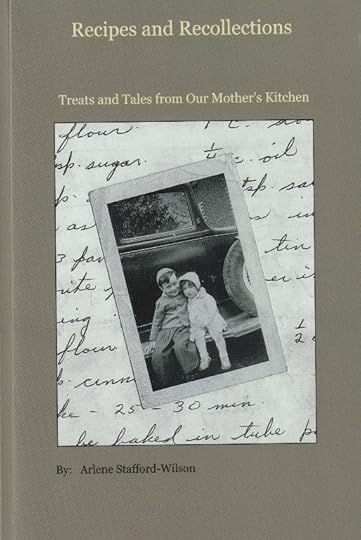
(available at: The Book Nook, Perth, Ontario, Spark Books, Perth, Ontario, and lanarkcountybooks@gmail.com)

Arlene Stafford-Wilson
Perth’s Haunted Hospital
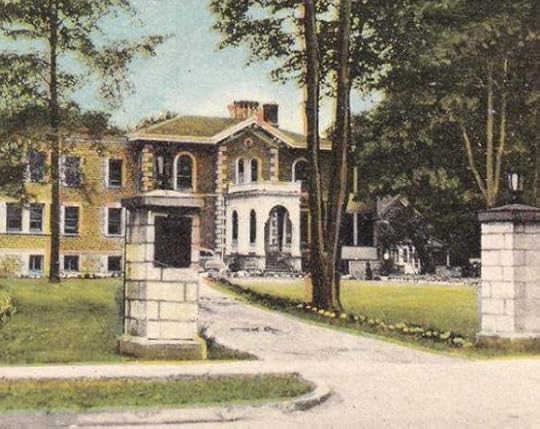
It wasn’t until I worked at the Perth hospital kitchen in the 1970s, that I began hearing stories about the ghosts that haunted their halls at night.
Although I was born in the Great War Memorial Hospital, and years later would attend high school just a block away, no one had ever mentioned the legends surrounding the original owners of the building, or how that family had been cursed.
Curious to find out more, I began to ask around town. Being a small town where everyone knew someone, who knew something; it didn’t take long before I spoke with someone, who knew someone else, who’d seen something unusual at the old hospital. I began to write down some of the stories about the building on Drummond Street that I thought, had always been a hospital. I discovered that it hadn’t started out as a hospital at all.
The story begins with a Judge John Malloch, a prominent citizen of the early days in Perth, who decided in 1858 to build an opulent stone house on Drummond Street. His home had all of the bells and whistles. There were 17 rooms, along with two large halls that were each ten feet wide. There was a solid walnut staircase, a large library, and a fine polished marble mantelpiece. In those days, it was considered by many, to be one of the finest homes in all of Eastern Ontario. The Judge named the home Victoria Hall, for the reigning Queen at that time.
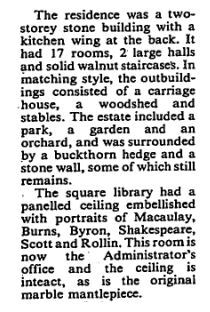
Judge Malloch had ordered many luxurious materials and finishes for his home, some from a distance, and he often became impatient because his building supplies didn’t arrive on time. One of his suppliers had promised delivery on a certain date and the materials did not arrive when needed. This caused a critical delay in construction. Workers were not able to proceed, and the setback cost the Judge a great deal of money. When the material finally arrived, the Judge was so annoyed that he refused to pay.
The supplier became extremely agitated, because even though he admitted that he was very late, he stressed to the Judge that he had delivered the supplies as agreed, so he felt that he should be paid. The supplier argued at length with the Judge, but Malloch stood firm and refused to pay. In the heat of the argument the supplier cursed the Judge. He went on to say that the Judge’s entire family would be cursed for as long as they lived in that house.

Years later, some would say that it was the curse, and some said that it was merely coincidence, that caused the Malloch family members to suffer ill health. Some even succumbed to death prematurely. The old Judge watched as they passed one by one, and he was left all alone in the large stately house.

Fifteen years after the house was built, the old Judge died, and the once elegant Victoria Hall was left vacant.
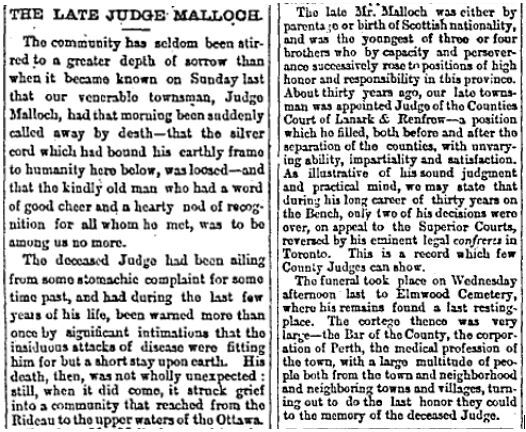
The only time the house was occupied was when distant family members would open the home for the summer season, stay briefly, then leave the house empty and dark for the remainder of the year.
It was during this time, when the house was left vacant, that locals passing by at night often noticed figures walking the halls or staring out the windows. Victoria Hall became known as the Haunted House of Perth.

Some said they saw what looked like a thin, sickly. old woman, standing at the window, staring down at Drummond Street below. Others claimed that they saw the ghost of the old white-haired judge, walking up and down the long halls, as if he was searching for something or someone.
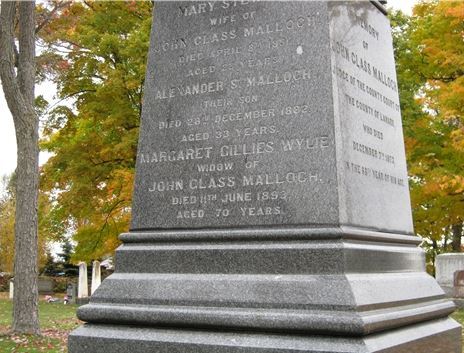
The Perth hospital, in the former Victoria Hall, opened in 1923. On Armistice Day in 1924 the town of Perth dedicated the hospital as a tribute to the men and women who served in World War I, and proclaimed that it would be known as the Great War Memorial Hospital.

By the time I was hired to work part-time in the hospital kitchen in 1976, there had been many additions, although by that time, the number of beds had been reduced. The provincial Ministry of Health imposed bed closures in the obstetrics ward in 1973 and local mothers had to travel to Smiths Falls to have their babies.
I recall that this was a heated issue at the time, and three years later, when I worked in the kitchen, it was still a topic of great discussion. The other topic, which I overheard many times discussed by the staff, were the ghosts that walked the halls at night.
Being a fairly level-headed person, I was inclined to take the ghost stories with a grain of salt, and went about my usual tasks. I’d been hired part-time to work in the evenings, to deliver trays of food to the patients, after school, and on weekend mornings, to help out with the breakfast preparations.
I recall the first day of work, when I went inside the hospital, and asked one of the staff in the lobby if they could tell me how to get to the kitchen. I got directions, and headed down the elevator to the lower level. When I arrived one of the other part time girls, Darlene Dowdall, took me on a tour of the kitchen, and introduced me to the staff. Dorothy Erwin was the kitchen supervisor. She said she’d be happy to answer any questions, and welcomed me to the kitchen. A few years later, Dorothy’s daughter Ruth, married my brother Roger, but that’s another story.
Next, Darlene brought me over to meet the cook. His name was Wayne Clapp, and he had a quick smile, and was joking around with Leonard ‘Lenny’ Parsons, the dishwasher. Wayne was preparing a beef stew, and he showed me the walk-in refrigerators. I couldn’t believe the size of those things. They were huge.
The next person I met in the kitchen was the baker, and her name was Gladys Thomas. She had a warm personality and very kind eyes. The day I met her she was busy making some vanilla pudding. She had a double-decker bake-oven, mounted on the wall behind her, and an enormous mixer for puddings and cakes.
Leonard Parsons, who I’d met earlier, came breezing by and asked if I’d like to start work by helping him wash some of the pots and pans. Darlene said she’d catch up with me later, and I followed Leonard into the dish-washing room.
Mike, the evening dishwasher, poked his head in the door and with a nervous look on his face, told Leonard that ‘Miss Bosch’ was coming. Leonard explained that Miss Gabriela Bosch was the head of the kitchen, the ‘big’ boss, and she would often drop by for a surprise inspection to make sure that everything was done just so.
He had barely finished his sentence when a very tall, dark-haired lady, wearing a white lab coat, poked her head into the doorway, said hello, and asked how everything was going. She was taller than average, and seemed very serious, and I wondered if that’s why the two men had seemed so nervous.
One of the other part time girls Heather Bell, came in and asked me if I could help her fill up the pop machine in the cafeteria. I recognized Heather from school. There were two Heather Bells, one with dark hair, but this was the blonde one, and she went by Heather ‘N.’ Bell so people would know which was which. Heather had a quick sense of humour, and she was a lot of fun to work with that evening. We joked around as we carted in the cases of pop and slotted them into the machine.
I spotted Bill Farrell coming into the cafeteria from the kitchen and he was holding a mop and pushing a bucket on wheels. He was tall and lanky and had a big smile for everyone. I recognized him from Perth High School, and he came over and introduced himself. He and Heather began joking around about some of the good time they’d had with the kitchen gang since they’d started working there and I knew for sure that there would be some fun times ahead.
Another girl from school Joy Hurren, worked behind the counter in the cafeteria, and she asked me if I’d like to help her fill some dishes with pudding. We spent about an hour doing that, and when we finished, we began to shut everything down for the night.
As we turned off the lights in the cafeteria, I heard an odd sound like someone moaning coming from inside the kitchen, but when I pushed the door open there was no one there. Joy just shook her head and seemed to think nothing of it; so, neither did I.
On my second night I worked with Joy’s younger sister Jennifer Hurren. She and I had been assigned the job of delivering supper to all of the patients. There were huge metal racks on wheels called carriers and every six inches or so there was a slot that held a tray of food.
The trays were already set with the evening meals. The dinner plates each had a metal cover to keep the food hot, and some of the trays had pots of tea or glasses of tomato juice or apple juice. Ethel Scott was working that evening putting the meals together. I recognized her because I went to school with her daughters, Judy, Thelma, and Patsy. Ethel was checking to make sure that the meals on the trays matched what the patient had checked off on their order slip.
Once we’d loaded the trays on the carrier, Jennifer and I rode up in the elevator, and stopped on the first floor. The big metal carrier was on wheels, so we pushed it along the hallway and stopped by each room. We made sure to check the slip of paper and match the name with the nameplate on the bed and then we set the tray down. Some of the patients were sleeping, but most were awake and happy to see us, and we chatted for a couple of minutes and then went onto the next room. There was one lady at the end of the hall who didn’t get a tray that night. Her room number wasn’t on the list. I thought to myself that she must have already eaten her supper earlier in the evening.
As the months passed by, I realized that the staff members in the hospital kitchen were a great bunch to work with. There were many jokes shared and stories told while we worked, and every so often someone would mention the ghosts that had been seen in the halls over the years. Well, I’d been up and down those halls many, many, months, and the only folks that I’d seen other than the nurses, were from the Hospital Auxiliary.
The ladies of the Hospital Auxiliary were a dedicated group and sometimes we’d see them in the halls. They’d be upstairs on the floors late at night delivering evening snacks to the patients. They called it the ‘Tea and Toast Brigade’ and brought around hot buttered toast with jam or jelly, and tea or juice to the patients, to provide a little late-night nourishment. Along with offering some cheer and a snack these ladies raised a tremendous amount of money for the hospital. They ran a little gift shop on site, and were also in charge of the Candy Stripers – young girls who volunteered to help out with small jobs around the hospital.
I saw quite a few of the ladies from the Hospital Auxiliary like Miss N. Burke, Mrs. Vi Wilson, Mrs. L. Crothers, Mrs. B Watson, Mrs. K. Frizell, Mrs. S. Folkard, Mrs. E. Rilley, Primrose Paruboczy, Harriet Halliday, and Mary McDougall. They were tireless workers, and it was very clear that they really cared about the patients and the hospital.
I also saw many of the local doctors while delivering the trays of food each evening. Many of them looked exhausted as they made their rounds, but they were always friendly and had a few kind words for us as we wheeled our food carrier down the halls. I remember Dr. Holmes and Dr. David Craig tending to their patients; and also Dr. J.A. Kidd, Dr. R. McLean and Dr. Tweedie.

We walked those halls on each floor of the hospital two or three nights each week, wheeling our meal carrier up and down, unloading the trays, chatting with the patients and the hard-working nurses. We dropped the trays off, came back later, picked up the empty trays, and brought them down to the kitchen.
I worked evenings in the hospital kitchen for almost two years. I heard many accounts during my time of staff members seeing apparitions. I thought that they must be imagining things, because I’d walked those halls at night countless times, I never encountered any ghosts at the GWM Hospital.
After graduating from PDCI, I worked two more months at the hospital kitchen, then headed off to college. I treasured the friendships formed there, and the building itself was impressive; particularly the original section of Victoria Hall, which at that time was used for administration. Being a keen student of history, it was interesting to learn about the early days, and also the many expansions and transitions that had taken place over the years.
On my last shift, there was a little gathering in the kitchen, and everyone wished me good luck in college. We loaded the trays in the carrier one last time, and headed into the elevator, and up to the second floor to deliver the evening meals. As we made our way to the end of the floor and emptied the carrier, a nurse walked by, and I stopped her, and asked a question that had been on my mind since I started working there.
“Sorry to bother you, but I’ve always wondered why the lady in the last room on the right never eats her supper at the same time as the other patients?”
The nurse gave me a puzzled look and said, “That’s just a utility room. We use it for storage. There hasn’t been a patient in there for years.”
I felt the blood drain from my face and a shiver ran down my spine, as I looked at her in disbelief, and then looked back down the hall toward the room. Was it possible that I had imagined the pale, slender lady with the snow-white hair, in the faded blue robe? Maybe she was from one of the other rooms …but why did she stand in front of the room at the end of the hall each evening?
The girl I was working with said, “Come on! We’ve got two more floors of meals to deliver tonight.”
The nurse had already started walking back to her station, and my co-worker was pulling the carrier down the hall toward the elevator. I finished my shift that evening, and hung up my smock in the change room for the last time.
I left out the side door that last night as usual, and headed up the curved pathway. Once I reached the sidewalk on Drummond Street, I looked back at the building where I’d worked the past two years. Suddenly it looked different, almost eerie, and I recalled what the nurse had said that night.
Who was that small, frail lady with the snow-white hair that I’d seen so many times? She never ate supper with the others. We never brought her a dinner tray. Was it my imagination? Was it just a coincidence?
Or, perhaps, this really was the ‘Haunted House of Perth’.
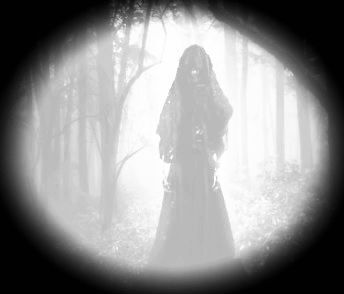

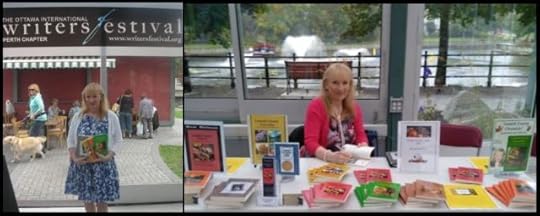
Arlene Stafford-Wilson
http://www.staffordwilson.comOctober 2, 2022
Book Review, “Lanark County Christmas”

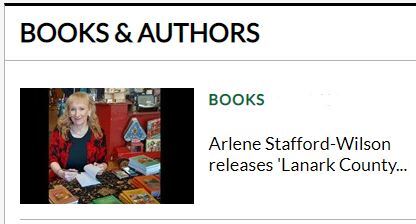
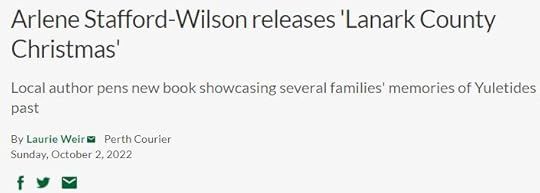
Just in time for holiday gift giving, Arlene Stafford-Wilson has released another fall reading classic, “Lanark County Christmas — Memories of a Yuletide Past.”
As in previous books that have showcased local families from Lanark County, and lists them alphabetically in an appendix for easy reference, this local author and genealogist includes many familiar names. But this time, there is a twist on her storytelling.
She offers chapters to others to tell their own personal tales of their Christmases in Lanark County. It’s a warm-cozy-hot chocolate-by-the-fire kind of book that is sure to have your own memories bubble to the surface.
More than 50 vignettes are shared by the sons and daughters of families who have settled in Perth and the surrounding area. They have brought to life their own holiday traditions.
From the 1940s to the 1980s, this classic will be one to pass down from generation to generation.
Who remembers making a Christmas wish list from the Eaton’s catalogue? Martha Craig does.
Dave Crosbie shares his memories of Christmas concerts at SS No. 1 in Lavant, or the Thurlow School.
Sleigh rides through the countryside — especially through the maple bushes of Lanark County — were popular among those who shared their Christmas memories, as was hunting for the perfect tree, shortbread and other Christmas cookie baking and, of course, watching the Perth Santa Claus Parade.
Christmases were spent with family — that is the common thread of all these heartwarming stories. Whether they came to Lanark County, or Lanark County visited from afar, the tradition of loved ones spending time together never fades.
Stafford-Wilson sets the stage with her own family memories. Her ancestors, who arrived here from Ireland in the 1800s, brought with them the tradition of Christmas cake, among other traditions.
“ … dried fruits were soaked in whiskey and rum, and more alcohol was added each day, as the fruit became increasingly plump and full,” she writes. “In preparation for ripening the cake, large square pieces of fresh clean cloth were dipped in hot water, then rubbed with flour to render them waterproof.”
Learn about the burning of the Yule log and its significance to Ireland. Wool socks were hung by the fire, and usually a toy made from wood and a ripe orange were discovered inside them on Christmas morning.
Stafford-Wilson said her father shared that it was a rare treat to get fruit when he was growing up, and an orange at Christmas was a juicy treat.
“The traditions and customs of our Irish ancestors were passed down through generations,” she writes, “from the very first settlers to present day.”
No matter how you mark the holiday season, may you find a little Christmas gift in your stocking by this author — it’s sure to pique the interest of many families in Lanark County.
“Lanark Country Christmas — Memories of a Yuletide Past” is available at the The Book Nook and Other Treasures, Spark Books and Curios, both in Perth; Mill Street Books in Almonte; or by contacting the author via her website at staffordwilson.com. You can also email lanarkcountybooks@gmail.com.
Laurie Weir : Editor of the Smiths Falls Record News and Perth Courier. Twitter @ljweir or IG @weir_on
September 29, 2022
Irish Feast of Michael – September 29th
Celebrating St. Michael’s Day, on September 29th, is an old Irish custom going back to the earliest times of the Celts. It was the day to mark the end of the harvest. On this day each year farmers would count their animals and decide how many they could afford to keep and feed over the long winter ahead, and how many would have to be sold and sent to slaughter. It was also a tribute to honour the three archangels, Angel Michael, Angel Gabriel, and Angel Raphael.
The Autumn Wind blows open the gate
St. Michael for you we wait
We follow you, show us the way
With joy we greet this Autumn day
Good Morning, Good Morning, Good Morning!
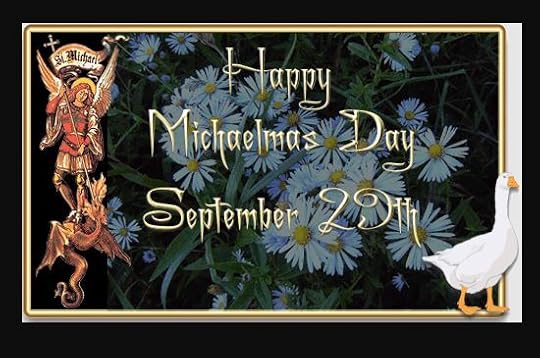
Michaelmas, (pronounced “mick-el-miss”) or St. Michael’s Day, was also a day for traditional county fairs, and of job fairs, where farmers could hire winter labour, after the end of the harvest. Families gathered and spent the day together and then shared a feast of freshly baked bread, roast goose, potatoes, and a glass or two of beer or whiskey.

St. Michael’s Day marked the end of the fishing season, and the beginning of the hunting season, and a traditional goose dinner was served in Irish homes to mark the occasion. In many parts of Ireland, farmers gave gifts of geese to the poor, and they also sold their down and feathers on that day at the local fairs, to be used for mattresses and pillows.
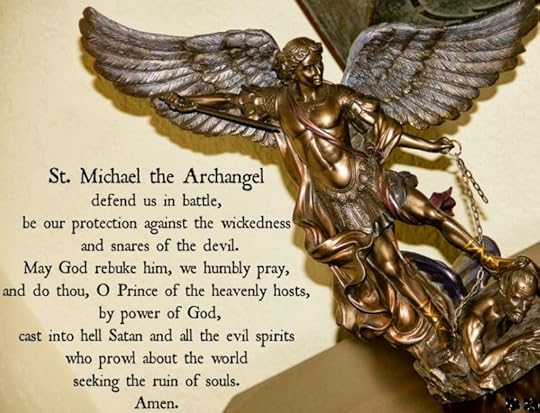
Michaelmas Pie
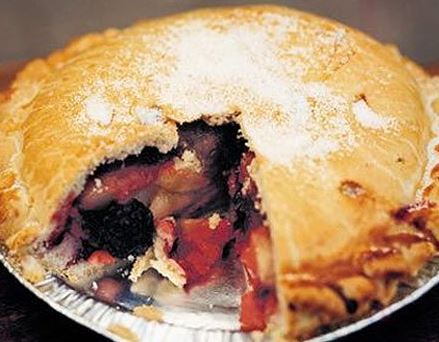
It was a custom to bake a Michaelmas pie, and to hide a ring in the pie. Whoever got the piece with the ring would be married within the year. The pies were made with apples and blackberries, which were ripe and delicious in late September. According to old Irish folklore, at Michaelmas, the devil spits on the blackberries after September 29th, so that is the last day to eat them safely. Irish legends say, when St. Michael cast Satan from Heaven, the devil landed on the Earth in a patch of blackberry brambles and he returns each year to spit on the plant that tortured him.
Goose for the Feast
During the Middle Ages, St. Michael’s Day was a religious feast in most of western Europe, celebrating the end of the harvest. It was the custom to eat a goose on Michaelmas, and legend tells that this ritual was supposed to protect against financial need for the next year.
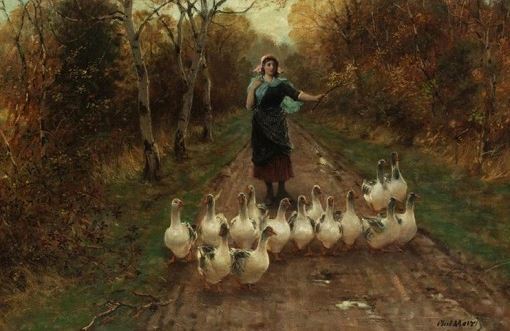
“He who eats goose on Michaelmas Day
shan’t money lack or debts to pay”

Predicting the
Winter Weather
The roasted goose was supposed to be eaten up by midnight on September 30th, and the breastbone was used to foretell the weather for the coming winter by holding it up to the light. A translucent breastbone meant that the winter ahead would be mild, while a thick cloudy breastbone meant it would be a long cold winter.
Potatoes and carrots were roasted in the goose fat, and a slice or two of Irish soda bread was served with the meal. Toasts were made to St. Michael, with Irish whiskey.

Recipe for Michaelmas Pie
INGREDIENTS
12 oz plain flour, sifted
1/2 tsp ground cinnamon
3 oz lard
3 oz chilled butter, diced
3 fl oz chilled water
pinch salt
2 lbs cooking apples
2 oz sugar
1 tsp ground cloves
1 tsp ground nutmeg
12 oz blackberries
1 egg, beaten
DIRECTIONS
Pre-heat the oven to 350 F.
Prepare the pastry. Place the flour in a mixing bowl and stir in the cinnamon and salt. Rub in the butter and lard until the mixture resembles fine breadcrumbs. Form a well in the centre and add the water. Mix together using a wire pastry blender, then knead briefly, and place in a plastic bag in the fridge. Leave to rest for 30 minutes.
Peel and core the apples. Cut them and place them in a saucepan with the sugar, cloves and nutmeg. Cover with a lid and gently simmer for 5 minutes, until the apples have softened. Next, fold in the blackberries and remove the saucepan from the heat. Cool the mixture.
Take pastry from the fridge and roll out two thirds on a lightly floured surface. Line an 8-inch metal pie plate. Pierce the base of the pastry with a fork. Strain the fruit, and spoon the fruit mixture over. Roll out the remaining pastry and lay the pastry over the fruit. Brush the base with a little egg and seal the edge. Trim and crimp the edges. Brush the surface with the remaining egg and with a knife make slits in the top. Bake for 35 minutes. Serve hot or cold with vanilla ice cream or fresh whipped cream.
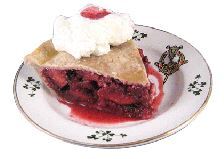
Is there a ‘Michael’
in your family?
The devotion to St. Michael in Ireland was so great, that at one time almost every family had a child named Michael. In 1923, Michael was the most popular name for boys in Ireland. In Catholic households, families with no boys would often give the name ‘Michael’ as a middle name for their daughters. At one time, it was not unusual for nuns to have the name of Sister Michael.

St. Michael is the Patron Saint of grocers, soldiers, doctors, mariners, paratroopers, and police, and it’s his responsibility to escort the faithful to heaven at their hour of death. He is known as the protector of humanity, who inspires the qualities of courage, initiative and steadfastness.
Irish Ancestry
For those with Irish heritage, September 29th, or St. Michael’s Day, is a day that we may choose to observe some of the old ways of our ancestors. In North America we might cook a chicken instead of a goose, and may substitute with blueberries or raspberries in our Michaelmas pies.
Whether we celebrate with a traditional Michaelmas feast on September 29th, or just have a wee shot of whiskey and a toast to St. Michael, it’s a day to pause for a moment and remember our ancestors, and how they marked the end of the harvest, and the beginning of a new season.
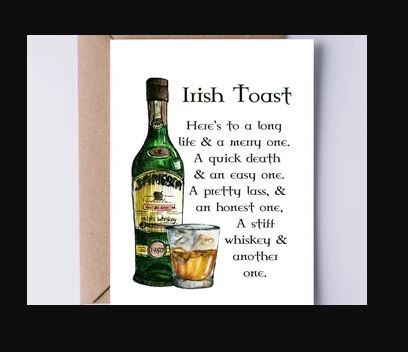
Slainte! “To Your Health!”
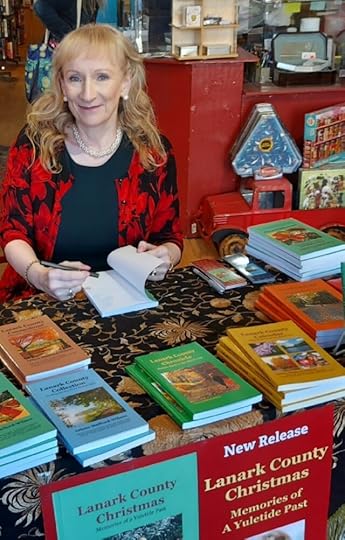
Arlene Stafford-Wilson
September 28, 2022
Antler Lodge – Dancing the Night Away in Cottage Country

Antler Lodge opened its doors for the first time on Friday evening, May 14th 1954. Admission was seventy-five cents, and they featured round and square dancing to live bands.

One of the opening acts at the Lodge was Lee Miller’s Orchestra, and they delighted the crowds weekend after weekend, for much of that first summer. Naturally, being a new venue, young people, and even some not-so-young people flocked to see the new Antler Lodge. There were curious tourists as well, who came to check out the newest dance hall in the region, and it became ‘the place to go’ in the summer of ’54. When the perennially popular Rideau Ferry Regatta wound down on the August long weekend, the Lodge became the hot-spot for the in-crowds, a place to mingle and mix, with some new faces, and the old familiar faces as well. Antler Lodge was a hit.
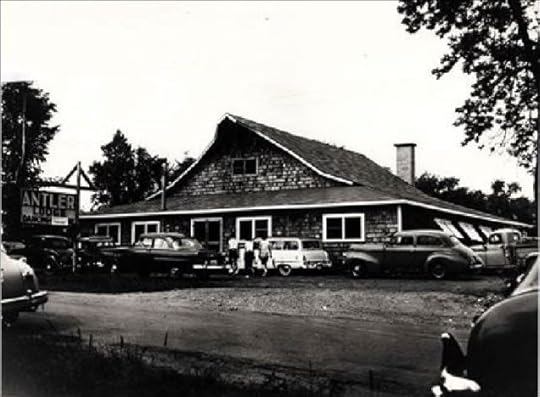
Dick and Margaret McLean, the owners of Antler Lodge, must have been pleased that first summer. Their new business was booming, a crowd-pleasing attraction, where people could gather together, dance, socialize, and enjoy some live country music.
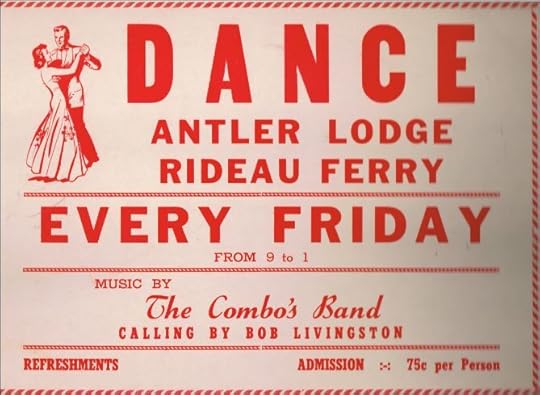
It’s anyone’s guess whether Antler Lodge would have ever existed, if Margaret and Dick hadn’t got together back in 1939. They were both local kids from Rideau Ferry. Margaret, the daughter of Mr. and Mrs. J.B. Jackson, and Richard, the son of Mr. and Mrs. James McLean

The McLean’s new business Antler Lodge would become an endearing and memorable place for so many, in the decades that followed.
As those first long, hot, summer weekends at Antler Lodge unfolded, the familiar strains of down-home country fiddling escaped the confines of the rustic wooden structure, and echoed over the fields, and across the Rideau lakes. Melodies from Hank Snow, Ray Price and Webb Pierce, played by local bands, filled the wooden rafters of the homespun Lodge, with hit after hit of trendy country and western tunes. The dancing went on until the wee hours; romances blossomed, and hearts were broken, to the tunes of Marty Robbins, Jim Reeves and Eddy Arnold. The parking lot was crammed with vehicles from Perth, Smiths Falls, Brockville, and even as far away as Kingston. Pretty girls posed demurely beside their date’s cars, decked out in pedal pushers or full skirts, flirting with their beaus, who sported narrow jeans, or pleated trousers. Shiny glass bottles of beer and liquor appeared from their hiding spots, tucked away, hidden carefully in glove boxes and trunks, and kisses were stolen in this parking lot, known to the neighbourhood teens as the passion pit.
Some kids hung out at the Rideau Ferry Inn, just up the road, but there was something about Antler Lodge; it was cozy, more intimate, more like a house party. The inside was spartan, unrefined, with exposed wooden beams, and a huge set of antlers mounted on the wall, above a homey, unpretentious, stone fireplace. In this casual, laid-back atmosphere, the lighting above the dance floor glowed soft, muted; perfect for swaying close, in dimly lit corners, and for long, steady, gazes into the eyes of a dance partner.
One of the first wedding receptions held at Antler Lodge was on October 19, 1955 as they played host to the delightful newlyweds Helen Kehoe and Tom Kerr. Helen was the daughter of Mr. and Mrs. Bernard Kehoe of Perth, and Thomas was the son of Mr. and Mrs. Francis Kerr of Stanleyville. The colourful autumn leaves set the stage for the joyful wedding, at St. John’s Church in Perth, officiated by Father Farrell. Shirley Anne Kehoe, the bride’s pretty sister, was the maid of honour, and the lovely Monica Kerr was her bridesmaid. At the groom’s side, stood his best man and brother, Walter Kerr, and his charming ushers escorting guests to their seats at St. John’s Church that day, were Pat Kehoe and Pat Kerr. Following the wedding, an elegant dinner was served in the Blue Room, at the Perth Hotel; and one of the highlights of this special day, was a memorable reception, at none other than Antler Lodge.
On June 12th 1956, Antler Lodge played host to a very special retirement party, for one of the area’s longest serving, and most respected municipal clerks – Roy Darou. An enthusiastic crowd of over 200 well-wishers and supporters, mostly citizens of North Elmsley Township, gathered to pay tribute to this local legend. Roy, a dedicated worker, had served the township faithfully, holding the same office for over forty years. There were glowing speeches that evening by Reeve James Coutts, appreciative tributes by Councillor Ferguson McVeety, many gifts, and warm wishes, from all who had gathered there. This was one of the earliest of such notable celebrations, to be held at the Lodge, in the coming decades.
Competition remained steady in the dance hall business throughout the summer of ’58, and ABC Hall in Bolingbroke began featuring bands every Friday night, advertising a variety of tempting refreshments, along with music by Lockwood’s Orchestra. At the Agricultural Hall in McDonald’s Corners, dances were usually held on Saturdays, and often their music was supplied by popular local group – Bill Hannah and the Nightingales. The admission price was considerably lower than the other halls, at the bargain-basement price of fifty cents for the evening. To remain competitive, Antler Lodge held a special Midnight Frolic, on Sunday August 3rd from 12:00 a.m. until 3:00 a.m., drawing huge crowds of racers and boating enthusiasts, following the annual Rideau Ferry Regatta.
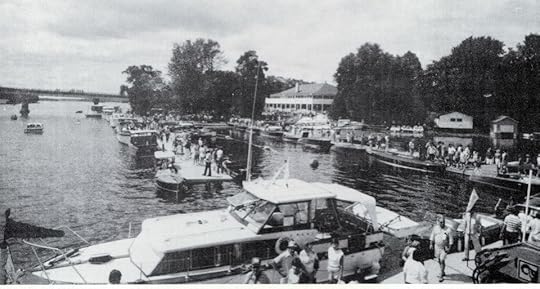
In the spring of 1959, Antler Lodge raised the bar for their opening dance of the season by featuring music by the famed Country Hoppers, stars of CKWS radio, Channel 11 TV, and RCA Victor records. They also increased the price of admission, and began to enforce a strict ‘no leather jackets or boots admitted’ policy, to discourage unsavory types from attending their dances, and causing trouble.
The Country Hoppers had a steady gig at the Lodge for the entire summer of ’59, and all through the cottage season in 1960 as well. People for miles around flocked to hear the sounds of country and western music, mingle, drink, and dance the night away.
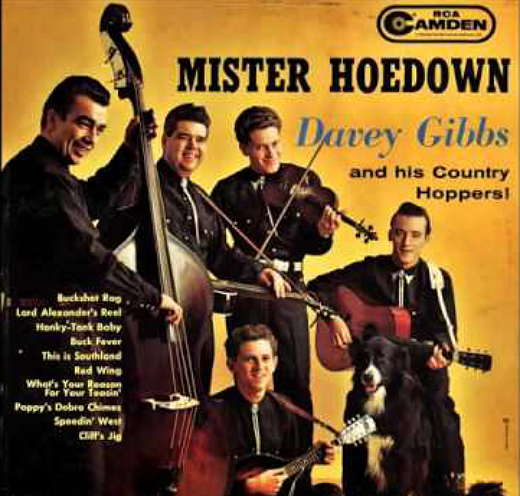
1961 would see an even greater increase in the popularity of area dance halls, and there were no less than eight local venues featuring live bands. The Stanley Lodge in Lanark constructed a new wooden dance platform, and hosted the Haylofters of CJOH TV, as well as the much sought after Ottawa Valley Melodiers.

John ‘Mac’ Beattie, Arnprior native, led the Melodiers, a legendary Ottawa Valley band on drums and vocals, with Reg Hill on fiddle, Garnet Scheel on guitar, Gaetan Fairfield on rhythm guitar, and Bob Whitney on saxophone. The band performed for decades, and released a total of seven albums, mostly in the 1960s.
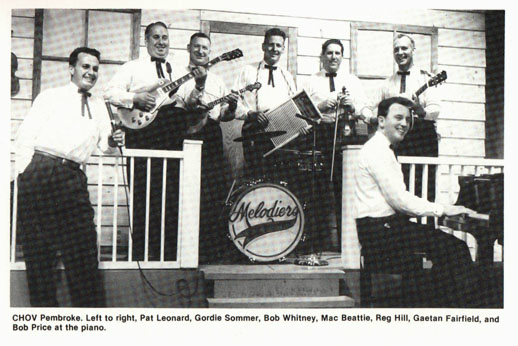
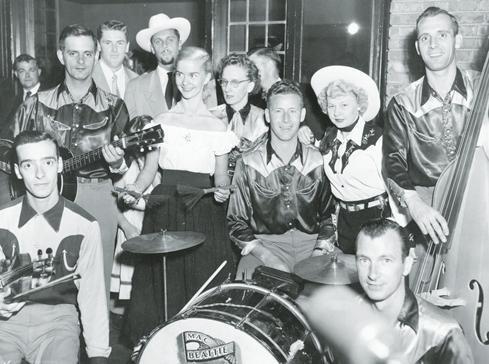
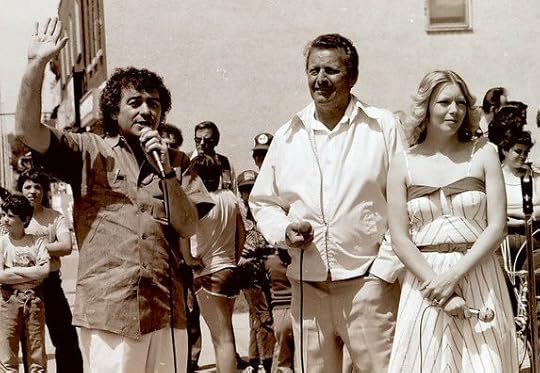
At McDonald’s Corners, music lovers could enjoy the sounds of the Country Rockets, playing weekends at the Agricultural Hall, and the Maberly Agricultural Hall featured Kenny Jackson’s Valley Cruisers. The Valley Cruisers had a distinctive country sound, highlighted by masterful fiddler Kenny Jackson, and polished performer Harry Adrain on guitar and vocals. The gifted Raymond ‘Raymie’ Donaldson played lead guitar, with the powerful strumming of Gary Barr on rhythm guitar, rounding out this dynamic group.
At Scott’s Ballroom in Westport, they featured round and square dancing, to the sounds of Fred Paquin’s Orchestra. Kingston native Don Cochrane got his start in the Fred Paquin Orchestra, as a teenager. Don would go on to collaborate on songs recorded by the Mercey Brothers, and would record two albums of his own music as well.
During that summer, Barker’s on Hwy 15, Otter Lake had music by Ron McMunn and his Country Cousins. Ron McMunn, or The Silver Fox, as he was known, hailed from Clayton, and in 1954, Ron formed the Country Cousins. His band performed live on CJET radio in Smiths Falls every Saturday night for over a decade and this set the stage for their tremendous popularity in local venues in the years that followed.


 Ron McMunn ‘The Silver Fox’
Ron McMunn ‘The Silver Fox’At the Fallbrook Orange Hall, the Mississippi River Boys provided the weekend entertainment, and at Antler Lodge, the Country Hoppers enjoyed their third steady year of regular engagements.
Early in that summer of 1961, the owners of Antler Lodge – Mr. and Mrs. Richard ‘Dick’ McLean announced the forthcoming marriage of their daughter Helen Isobel, to Mr. William Donald Robert ‘Don’ Halpenny. He was the son of Mr. and Mrs. R. Anson Halpenny, and hailed from Easton’s Corners. The marriage took place on July 7, at St. James Anglican Church in Perth.
Later, that same summer, Antler Lodge hosted former Perth High School classmates as they celebrated their Class of’44 reunion.

Following a tasty turkey supper at the Rideau Ferry Inn, everyone drove up the road to the Lodge for some live music and square dancing. It was a night to remember, and Gordon Mather was an entertaining Master of Ceremonies. There was a good turnout with Mr. and Mrs. Frank Frizell (Dorothy Ferguson), Bill Thomas, Mr. and Mrs. Willard Shaw (Vivian Greenley) , Dr. and Mrs. C. Campbell (Mary Ewart), Mr. and Mrs. Bernard Elliot (Kaye Ferguson), Mr. and Mrs. Gordon Mather, George Findlay, Mr. and Mrs. Ken Buchanan (Evelyn Radford), Mr. and Mrs. Don Goodfellow (Doreen Marcellin) Mr. and Mrs. Fred Guarino (Mid Stewart), Mr. and Mrs. Ron Thompson (Bette Oakes), Mrs. F. Cohis (Maxine Ramsbottom), Mr. and Mrs. George Leonard, Mr. and Mrs. Don Campbell (Marg Quartermain), Mr. and Mrs. T. Rockburn (Clara McInnis)
Several prizes were awarded during the evening: Man with the baldest head – Willard Shaw, runner-up Gordon Mather, Couple married the longest – Mr. and Mrs. Ken Buchanan, Couple married the shortest time – Bernard and Kaye Elliot, Couple travelling the longest distance – Mr. and Mrs. C. Cameron, Couple with an anniversary – Mr. and Mrs. Fred Guarino, and last, but not least – a prize for a bachelor – George Finlay.
The Country Hoppers, formerly known as the Riders of the Southern Trail, were a tremendously popular band, drawing large crowds from Carleton Place, Smiths Falls and Perth; and they became the regular weekend entertainment at Antler Lodge from 1962 through to 1966. Their first album ‘The Country Kid’ was released in 1962 and included performances by Davey Gibbs, Garry ‘Gizz’ Watt, Fred ‘Pappy’ Ryan, Paul ‘Hiker’ Gurry, and Larry ‘Dooley’ Protheroe. The Country Hoppers were known for their versatility and could play country fiddle tunes, honky-tonk, ballads, and square dance music as well.


…………
In the fall of ‘64, the Appleton Junior Farmers held a dance at the Lodge, featuring the Happy Wanderers. The Happy Wanderers, an Ottawa group, were immensely popular with teens, and had a regular show, every Saturday night, at the Carleton Place Town Hall. Ken Reynolds, Ward Allen, Bob King, Vince Lebeau, Joe Brown, and Lynn Strauff, formed the original CFRA Happy Wanderers, and they became one of the most popular acts in the Ottawa Valley.


They were also featured on a weekly half-hour show, on CFRA radio, broadcast across the Valley. When they played Antler Lodge, they brought special guests Marie King, Barry and Lawanda Brown. Bob Livingston kept the evening’s dancers moving around the floor like clockwork, as the caller for the square dancing.
A few years later, Barry and Lawanda, along with their father Joe, and their sister Tracey, would form The Family Brown, which included masterful lead guitarist Dave Dennison, and accomplished drummer, and capable band manager Ron Sparling.

Another talented group drawing crowds to the Lodge that year was the Country Harmony Boys. During the later part of ’64, Antler Lodge also featured the Top Hats and the Travelons.
By 1968 Antler Lodge had an established house band that entertained the crowds every Saturday night, during the entire cottage season. The Country Harmony Boys were a polished group of talented local musicians, and they drew the masses, young and old, to the Lodge, for their weekly fill of square dancing tunes.
Meanwhile, some of the other area dance halls were booming as well, and the popular Balderson Hall often featured Bill Munro and his Country Rockets, or Don Gilchrist and his Dancers, and they kept these cozy venues hopping until the wee hours. Donnie Gilchrist, a talented showman, was born in Campbell’s Bay. At one point in his career, he teamed up with the very capable Joan Ann Jamieson, and went on to become one of the legendary step-dancers of his time. He later caught the attention of Frank Ryan, founder of CFRA radio station, who helped to promote him on the local airwaves. Don rose from his humble beginnings in local dance halls, and went on to perform in 24 countries around the world, and even appeared on numerous TV specials.
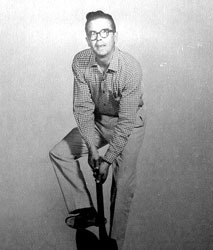
Frank Ryan of CFRA was key in promoting many of the local Ottawa Valley bands and helping them to succeed in a very competitive industry.
 CFRA’s Frank Ryan
CFRA’s Frank RyanBecause of their location, ABC Hall in Bolingbroke often had acts come in from the city of Kingston. One of the more sought-after bands in the summer of ’68 was Mallen’s Melodiers, playing both modern pop, and square dancing tunes. Not to be outdone, the hall at McDonald’s Corners regularly featured crowd-pleasing music by Symington’s Orchestra, for the very competitive admission price of seventy-five cents.
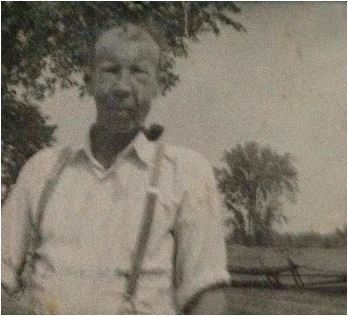
Antler Lodge hosted yet another high-profile wedding reception, when Beryl Kehoe married Robert Orok. On July 31st at St. John’s Church in Perth, Beryl, daughter of Mr. and Mrs. Lambert Kehoe of Rideau Ferry, became Mrs. Robert Orok. Robert’s parents Fred and Mona Orok were the founders and owners of the flourishing Orok’s Hardware Store in Lanark, and were well known and respected in the area. Rev. B.F. O’Neil made the journey all the way from Brockville to officiate the wedding. Highlights of the ceremony included memorable music, played by talented organist Mrs. Robert McTavish, and a heartfelt solo sung by the gifted David St. Onge.
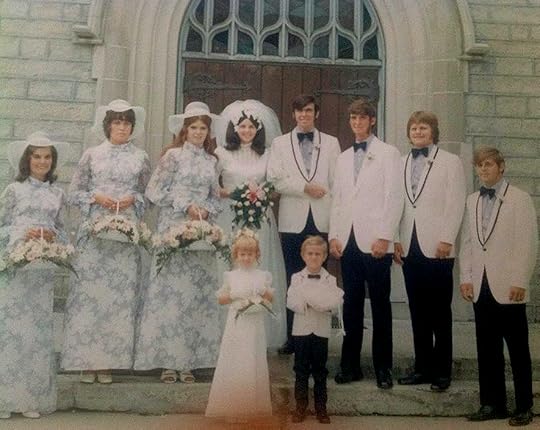
Standing up with Beryl was dear friend Kathryn Campbell, Maid of Honour, and two lovely Bridesmaids – Darlene Beveridge and Judith Orok. William Neilson was the dashing best man, accompanied by two charming ushers, Richard Kellar and Bernard Kehoe. Two delightful youngsters taking part in the ceremony were Alison Kerr, the bride’s cousin as flower girl, and small, but capable Conrad Potvin had the all-important task of ring-bearer.

While Antler Lodge was growing in popularity during the ‘50s and ‘60s, there was an undeniable musical revolution taking place in England; and the distinctive beat of rock and roll music was spreading across the ocean, to North America. It was called the British Invasion, and groups like The Beatles, The Dave Clark Five, The Kinks, The Rolling Stones, Herman’s Hermits and The Who, began to get air-time on Canadian radio stations. By the mid 1960s rock and roll was dominating the local airwaves, and by the late ‘60s and early ‘70s, many young people followed the trendy new music, and wanted to hear rock music played live in local venues.
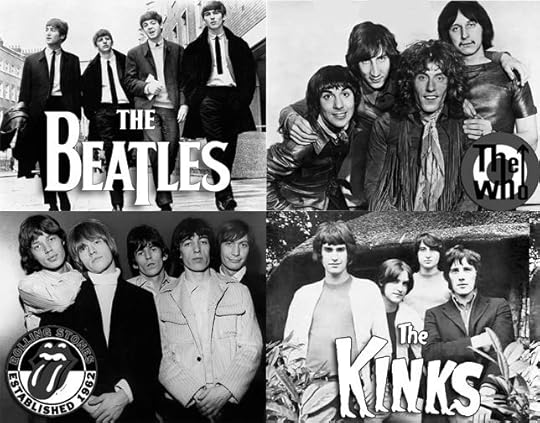
Antler Lodge had always been a country music venue. The rustic, intimate, hall, attracted large, enthusiastic crowds, with their talented live bands, and memorable evenings of western-style square dancing. As more and more young people gravitated toward rock and roll music, the crowds at the nearby Rideau Ferry Inn began to grow in leaps and bounds. The Rideau Ferry Inn featured live rock and roll bands, or disc jockeys, and by the late 1960s and early 1970s enjoyed the lion’s share of the weekend business. Country and western music, during those years, lost its appeal with the majority of the young crowds; although it remained as well-loved as ever, with the older generation.
 Rideau Ferry Inn
Rideau Ferry InnThe once hugely popular country dance hall was simply not able to compete with the cutting-edge music at the Rideau Ferry Inn, or the latest rock groups playing at the Perth arena or Farrell Hall, like Max Webster, April Wine and Lighthouse. The declining business continued to operate on a smaller scale through the summer of 1975, but by August of 1976 Antler Lodge had given up, locked its doors, and was up for sale. A small ad in the real estate section of the “Perth Courier” was published on Thursday, August 5th: “Antler Lodge, Rideau Ferry, approx 6 miles from Perth. Stone fireplace, maple floor, stage and lunch counter.” Two years later, in 1978, the Lodge was still for sale – “This once thriving lodge is situated on a one acre lot. Inquire today. $35,000.”
………
It was shortly after midnight on Friday, October 9, 1981, when the Bathurst, Burgess, Drummond and North Elmsley (BBDE) Fire Department received the call. According to Fire Chief Harold Jordan, flames were shooting through the roof of Antler Restaurant, within six minutes of the call. Eighteen local fire fighters responded to the call, bravely battling thick smoke and hot, scorching flames; but according to Harold, “We couldn’t save anything.”
 Perth Courier, October 9, 1981
Perth Courier, October 9, 1981………
“The local fire department was unable to establish the cause of the blaze, and it remains a mystery why the Ontario Fire Marshals were never called in to investigate the source of the fire that completely leveled Antler Lodge.”
……….



…………………
** The fact that there was never an investigation into the cause of the fire that destroyed this beloved dance hall, remains a mystery even today!
………………..
photos of Antler Lodge, used with permission – Graeme Hoatson Beattiephotos of Dick and Margaret ‘Marnie’ McLean, owners of Antler Lodge, used with permission of Carol Ann Moore McDonald (Carol is the niece of Dick and Marnie McLean, on her mother’s side)photos of Orok-Kehoe wedding, used with permission – Beryl Orokphoto: Antler Lodge poster – printed by Thompson Printing, Perth, used with permission – Jim Winton………………
(this story is an excerpt from the book ‘Lanark County Connections: Memories Among the Maples’ – available:The Book Nook, 60 Gore St. E., Perth, Ontario: https://thebooknookperth.com/product/lanark-county-connections-arlene-stafford-wilson/
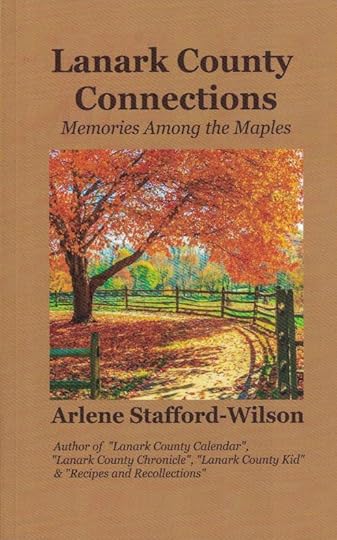
also at:
Spark Books & Curios, 76 Foster Street, Perth, Ontario https://sparkperth.ca/
and
Mill Street Books, 52 Mill Street, Almonte, Ontario – https://millstreetbooks.com/
……………..
For more information on dance halls and musicians in Lanark County:
more on Lanark County Dance Halls

Arlene Stafford-Wilson




